FOOD ADDITIVES AND PRESERVATIVES
VerifiedAdded on 2022/04/26
|26
|8178
|42
AI Summary
Food Additives and preservatives have been in use in foods for centuries. When meats are smoked as means of preserving them, compounds such as butyl gallate and butylated hydroxyl anisole (BHA) are formed and provide both bacteriostatic and antioxidant effects.
Contribute Materials
Your contribution can guide someone’s learning journey. Share your
documents today.
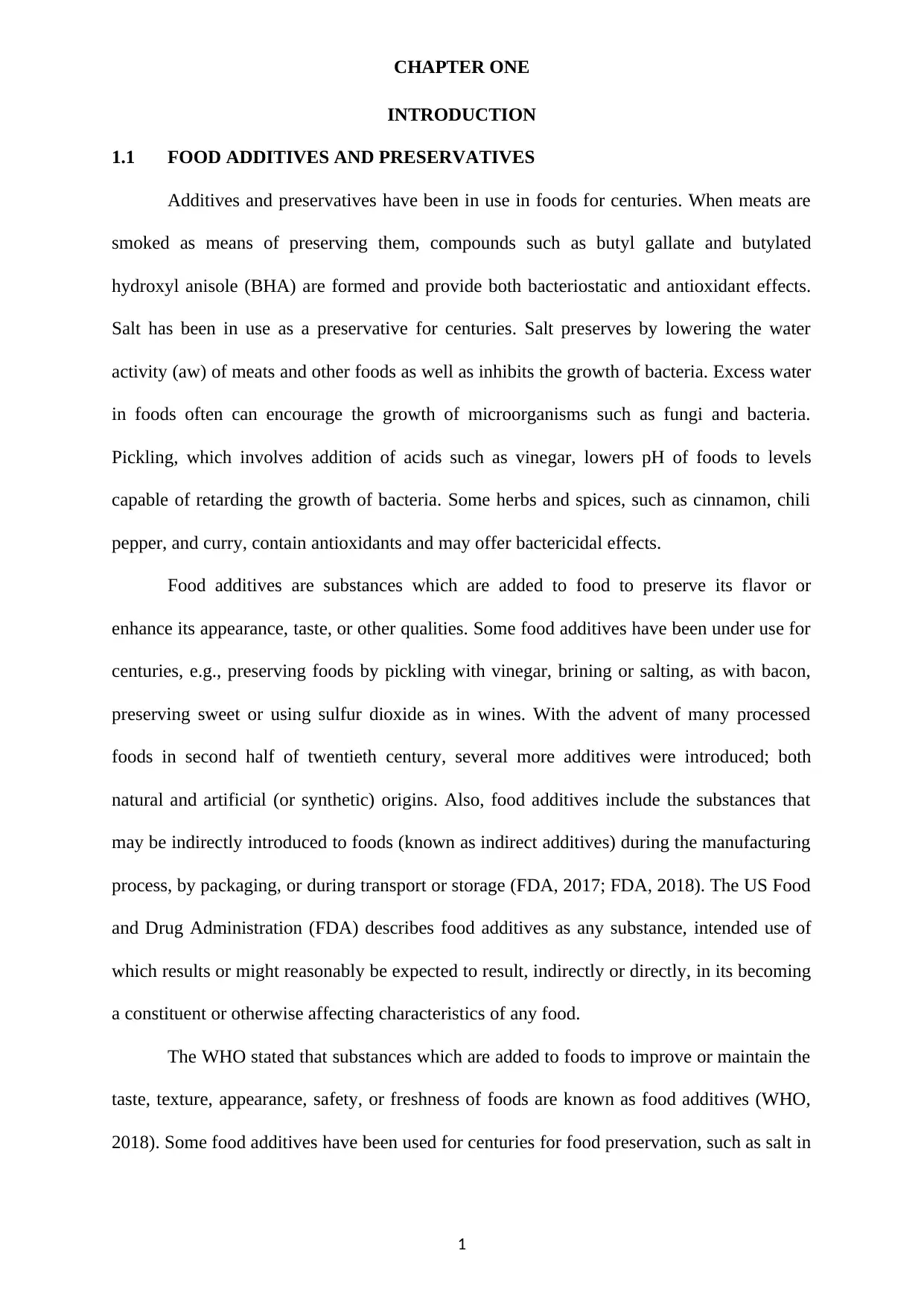
CHAPTER ONE
INTRODUCTION
1.1 FOOD ADDITIVES AND PRESERVATIVES
Additives and preservatives have been in use in foods for centuries. When meats are
smoked as means of preserving them, compounds such as butyl gallate and butylated
hydroxyl anisole (BHA) are formed and provide both bacteriostatic and antioxidant effects.
Salt has been in use as a preservative for centuries. Salt preserves by lowering the water
activity (aw) of meats and other foods as well as inhibits the growth of bacteria. Excess water
in foods often can encourage the growth of microorganisms such as fungi and bacteria.
Pickling, which involves addition of acids such as vinegar, lowers pH of foods to levels
capable of retarding the growth of bacteria. Some herbs and spices, such as cinnamon, chili
pepper, and curry, contain antioxidants and may offer bactericidal effects.
Food additives are substances which are added to food to preserve its flavor or
enhance its appearance, taste, or other qualities. Some food additives have been under use for
centuries, e.g., preserving foods by pickling with vinegar, brining or salting, as with bacon,
preserving sweet or using sulfur dioxide as in wines. With the advent of many processed
foods in second half of twentieth century, several more additives were introduced; both
natural and artificial (or synthetic) origins. Also, food additives include the substances that
may be indirectly introduced to foods (known as indirect additives) during the manufacturing
process, by packaging, or during transport or storage (FDA, 2017; FDA, 2018). The US Food
and Drug Administration (FDA) describes food additives as any substance, intended use of
which results or might reasonably be expected to result, indirectly or directly, in its becoming
a constituent or otherwise affecting characteristics of any food.
The WHO stated that substances which are added to foods to improve or maintain the
taste, texture, appearance, safety, or freshness of foods are known as food additives (WHO,
2018). Some food additives have been used for centuries for food preservation, such as salt in
1
INTRODUCTION
1.1 FOOD ADDITIVES AND PRESERVATIVES
Additives and preservatives have been in use in foods for centuries. When meats are
smoked as means of preserving them, compounds such as butyl gallate and butylated
hydroxyl anisole (BHA) are formed and provide both bacteriostatic and antioxidant effects.
Salt has been in use as a preservative for centuries. Salt preserves by lowering the water
activity (aw) of meats and other foods as well as inhibits the growth of bacteria. Excess water
in foods often can encourage the growth of microorganisms such as fungi and bacteria.
Pickling, which involves addition of acids such as vinegar, lowers pH of foods to levels
capable of retarding the growth of bacteria. Some herbs and spices, such as cinnamon, chili
pepper, and curry, contain antioxidants and may offer bactericidal effects.
Food additives are substances which are added to food to preserve its flavor or
enhance its appearance, taste, or other qualities. Some food additives have been under use for
centuries, e.g., preserving foods by pickling with vinegar, brining or salting, as with bacon,
preserving sweet or using sulfur dioxide as in wines. With the advent of many processed
foods in second half of twentieth century, several more additives were introduced; both
natural and artificial (or synthetic) origins. Also, food additives include the substances that
may be indirectly introduced to foods (known as indirect additives) during the manufacturing
process, by packaging, or during transport or storage (FDA, 2017; FDA, 2018). The US Food
and Drug Administration (FDA) describes food additives as any substance, intended use of
which results or might reasonably be expected to result, indirectly or directly, in its becoming
a constituent or otherwise affecting characteristics of any food.
The WHO stated that substances which are added to foods to improve or maintain the
taste, texture, appearance, safety, or freshness of foods are known as food additives (WHO,
2018). Some food additives have been used for centuries for food preservation, such as salt in
1
Secure Best Marks with AI Grader
Need help grading? Try our AI Grader for instant feedback on your assignments.

meats like bacon or dried fish, sulfur dioxide in wine, or sugar in marmalade. Food additives
may also be used to confer a specific functional property in foods (Chinaza, 2019b; Chinaza
et al., 2019a). Over time, many food additives have been developed to meet the requirements
of food production and food industries, as producing foods on large scale is quite different
from making on a small scale at home or for household. Additives are required to ensure the
processed foods remain safe, in good condition, and fresh throughout its journey from the
factories or industries, during the course of transportation to shops and warehouses, and
finally to the consumers, who often look out for fresh, safe, nutritious, and wholesome foods.
The use of additives in foods is only justified when their use does not mislead
consumers, has technological need, and serves well-defined technological function, such as to
enhance the stability of the food or preserve the nutritional quality of the food. Food additives
can be derived from animals, plants, or minerals, or can be synthetic. They are added to food
intentionally to perform some technological purposes which the consumers often take for
granted (WHO, 2018), or unintentionally added through food-package interactions or from
other sources such as pesticides used in growing crops, mycotoxins such as aflatoxin, patulin
(Chinaza et al., 2019b) found in grains and other foods; also, some components such as
methanol and ethyl carbamate (Igwe et al., 2018a; Igwe et al., 2018b) may be formed in some
traditional beverages and become part of the foods.
There are several thousand food additives in use, which are all designed to do specific
job in making foods more appealing, safer, or nutritious. Bisphenols, perfluoroalkyl
chemicals (PFCs), and phthalates are indirect additives used in packaging or manufacturing.
In July 2018 the American Academy of Pediatrics (AAP) called for more study of
Bisphenols, perfluoroalkyl chemicals (PFCs), and phthalates, along with food coloring and
nitrates, as they might harm the children during development (American Academy of
Pediatrics, 2018). The safety assessments completed by the Joint Expert Committee on Food
Additives (JECFA) are used by the Codex Alimentarius Commission, a joint
2
may also be used to confer a specific functional property in foods (Chinaza, 2019b; Chinaza
et al., 2019a). Over time, many food additives have been developed to meet the requirements
of food production and food industries, as producing foods on large scale is quite different
from making on a small scale at home or for household. Additives are required to ensure the
processed foods remain safe, in good condition, and fresh throughout its journey from the
factories or industries, during the course of transportation to shops and warehouses, and
finally to the consumers, who often look out for fresh, safe, nutritious, and wholesome foods.
The use of additives in foods is only justified when their use does not mislead
consumers, has technological need, and serves well-defined technological function, such as to
enhance the stability of the food or preserve the nutritional quality of the food. Food additives
can be derived from animals, plants, or minerals, or can be synthetic. They are added to food
intentionally to perform some technological purposes which the consumers often take for
granted (WHO, 2018), or unintentionally added through food-package interactions or from
other sources such as pesticides used in growing crops, mycotoxins such as aflatoxin, patulin
(Chinaza et al., 2019b) found in grains and other foods; also, some components such as
methanol and ethyl carbamate (Igwe et al., 2018a; Igwe et al., 2018b) may be formed in some
traditional beverages and become part of the foods.
There are several thousand food additives in use, which are all designed to do specific
job in making foods more appealing, safer, or nutritious. Bisphenols, perfluoroalkyl
chemicals (PFCs), and phthalates are indirect additives used in packaging or manufacturing.
In July 2018 the American Academy of Pediatrics (AAP) called for more study of
Bisphenols, perfluoroalkyl chemicals (PFCs), and phthalates, along with food coloring and
nitrates, as they might harm the children during development (American Academy of
Pediatrics, 2018). The safety assessments completed by the Joint Expert Committee on Food
Additives (JECFA) are used by the Codex Alimentarius Commission, a joint
2
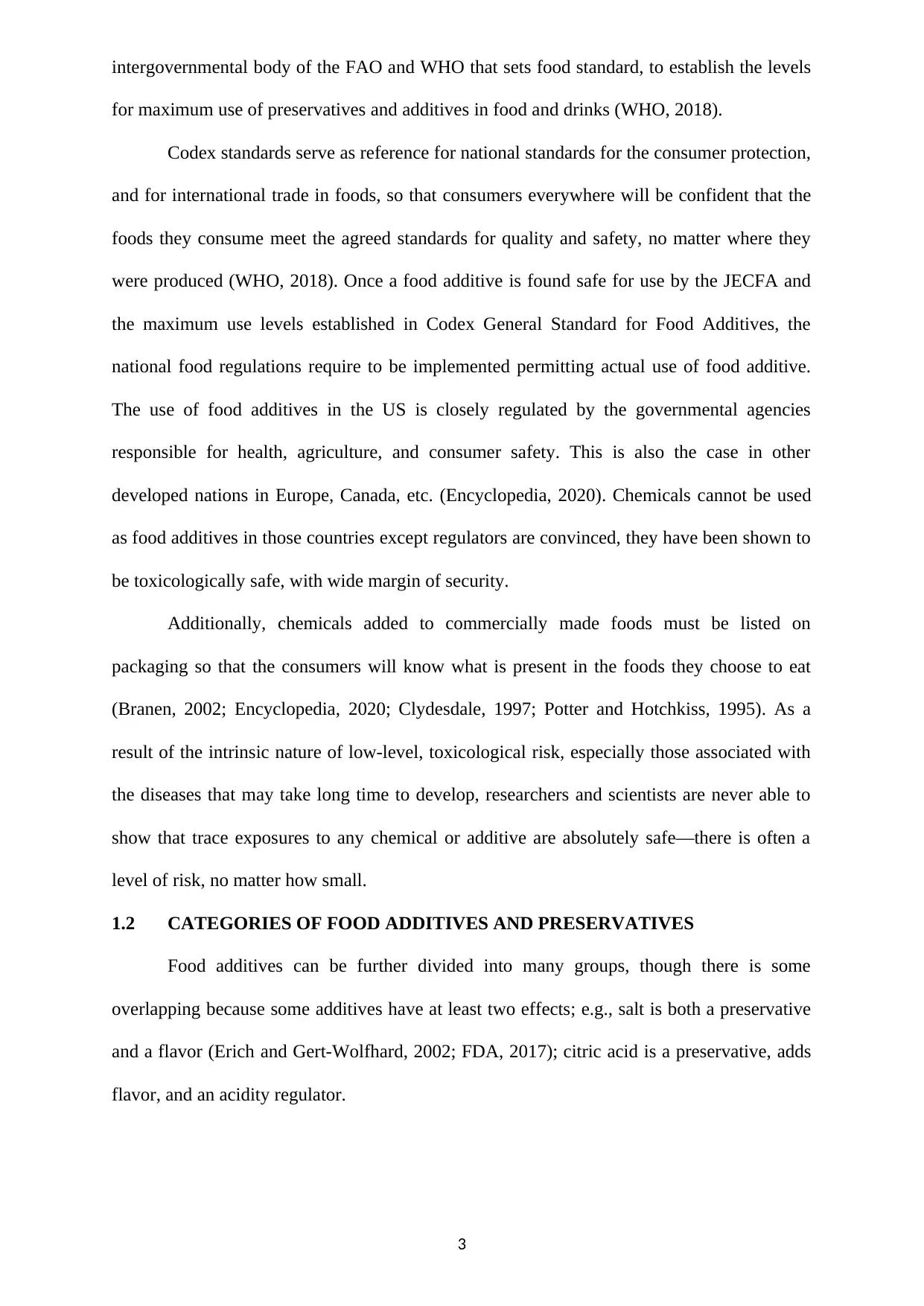
intergovernmental body of the FAO and WHO that sets food standard, to establish the levels
for maximum use of preservatives and additives in food and drinks (WHO, 2018).
Codex standards serve as reference for national standards for the consumer protection,
and for international trade in foods, so that consumers everywhere will be confident that the
foods they consume meet the agreed standards for quality and safety, no matter where they
were produced (WHO, 2018). Once a food additive is found safe for use by the JECFA and
the maximum use levels established in Codex General Standard for Food Additives, the
national food regulations require to be implemented permitting actual use of food additive.
The use of food additives in the US is closely regulated by the governmental agencies
responsible for health, agriculture, and consumer safety. This is also the case in other
developed nations in Europe, Canada, etc. (Encyclopedia, 2020). Chemicals cannot be used
as food additives in those countries except regulators are convinced, they have been shown to
be toxicologically safe, with wide margin of security.
Additionally, chemicals added to commercially made foods must be listed on
packaging so that the consumers will know what is present in the foods they choose to eat
(Branen, 2002; Encyclopedia, 2020; Clydesdale, 1997; Potter and Hotchkiss, 1995). As a
result of the intrinsic nature of low-level, toxicological risk, especially those associated with
the diseases that may take long time to develop, researchers and scientists are never able to
show that trace exposures to any chemical or additive are absolutely safe—there is often a
level of risk, no matter how small.
1.2 CATEGORIES OF FOOD ADDITIVES AND PRESERVATIVES
Food additives can be further divided into many groups, though there is some
overlapping because some additives have at least two effects; e.g., salt is both a preservative
and a flavor (Erich and Gert-Wolfhard, 2002; FDA, 2017); citric acid is a preservative, adds
flavor, and an acidity regulator.
3
for maximum use of preservatives and additives in food and drinks (WHO, 2018).
Codex standards serve as reference for national standards for the consumer protection,
and for international trade in foods, so that consumers everywhere will be confident that the
foods they consume meet the agreed standards for quality and safety, no matter where they
were produced (WHO, 2018). Once a food additive is found safe for use by the JECFA and
the maximum use levels established in Codex General Standard for Food Additives, the
national food regulations require to be implemented permitting actual use of food additive.
The use of food additives in the US is closely regulated by the governmental agencies
responsible for health, agriculture, and consumer safety. This is also the case in other
developed nations in Europe, Canada, etc. (Encyclopedia, 2020). Chemicals cannot be used
as food additives in those countries except regulators are convinced, they have been shown to
be toxicologically safe, with wide margin of security.
Additionally, chemicals added to commercially made foods must be listed on
packaging so that the consumers will know what is present in the foods they choose to eat
(Branen, 2002; Encyclopedia, 2020; Clydesdale, 1997; Potter and Hotchkiss, 1995). As a
result of the intrinsic nature of low-level, toxicological risk, especially those associated with
the diseases that may take long time to develop, researchers and scientists are never able to
show that trace exposures to any chemical or additive are absolutely safe—there is often a
level of risk, no matter how small.
1.2 CATEGORIES OF FOOD ADDITIVES AND PRESERVATIVES
Food additives can be further divided into many groups, though there is some
overlapping because some additives have at least two effects; e.g., salt is both a preservative
and a flavor (Erich and Gert-Wolfhard, 2002; FDA, 2017); citric acid is a preservative, adds
flavor, and an acidity regulator.
3
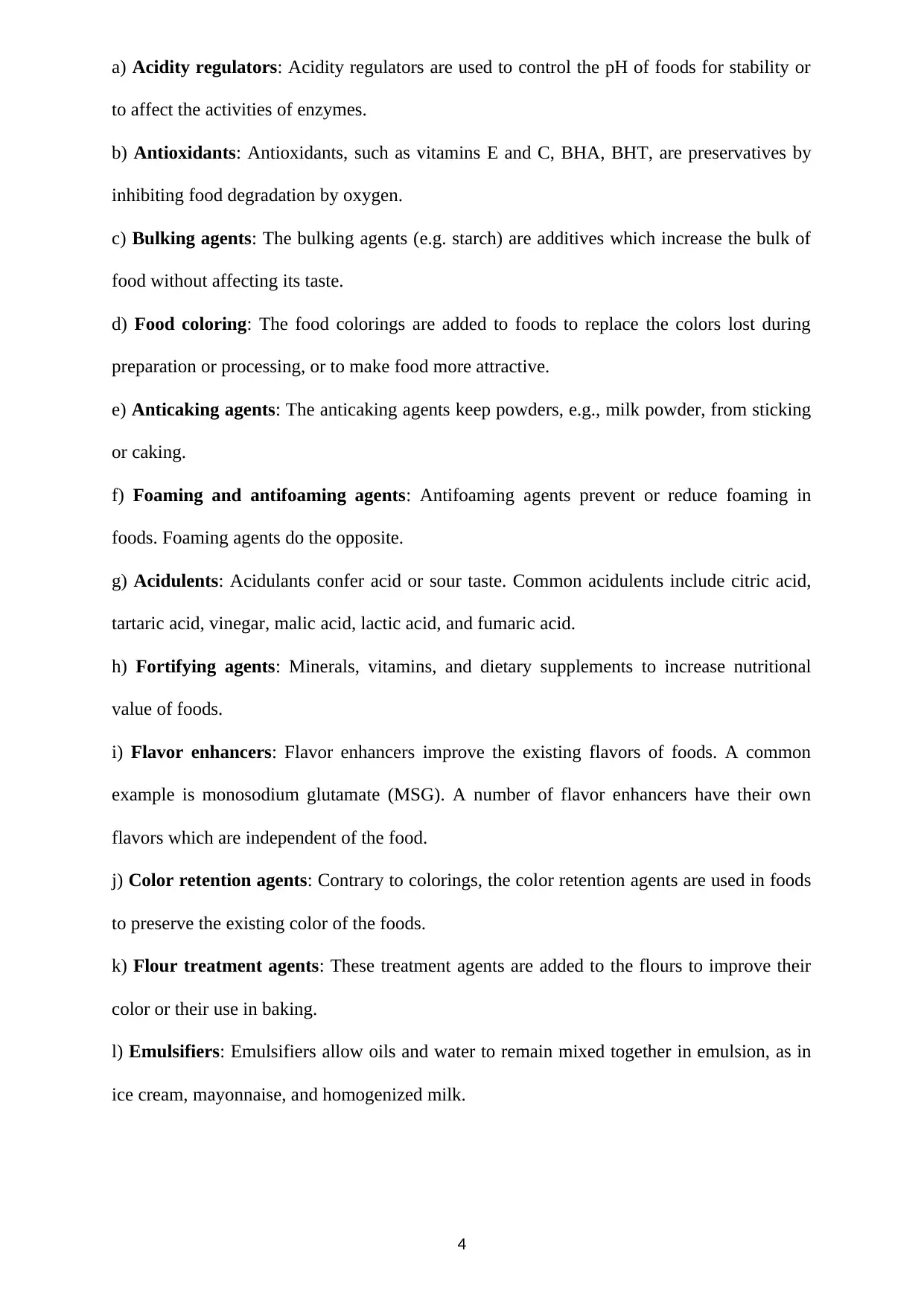
a) Acidity regulators: Acidity regulators are used to control the pH of foods for stability or
to affect the activities of enzymes.
b) Antioxidants: Antioxidants, such as vitamins E and C, BHA, BHT, are preservatives by
inhibiting food degradation by oxygen.
c) Bulking agents: The bulking agents (e.g. starch) are additives which increase the bulk of
food without affecting its taste.
d) Food coloring: The food colorings are added to foods to replace the colors lost during
preparation or processing, or to make food more attractive.
e) Anticaking agents: The anticaking agents keep powders, e.g., milk powder, from sticking
or caking.
f) Foaming and antifoaming agents: Antifoaming agents prevent or reduce foaming in
foods. Foaming agents do the opposite.
g) Acidulents: Acidulants confer acid or sour taste. Common acidulents include citric acid,
tartaric acid, vinegar, malic acid, lactic acid, and fumaric acid.
h) Fortifying agents: Minerals, vitamins, and dietary supplements to increase nutritional
value of foods.
i) Flavor enhancers: Flavor enhancers improve the existing flavors of foods. A common
example is monosodium glutamate (MSG). A number of flavor enhancers have their own
flavors which are independent of the food.
j) Color retention agents: Contrary to colorings, the color retention agents are used in foods
to preserve the existing color of the foods.
k) Flour treatment agents: These treatment agents are added to the flours to improve their
color or their use in baking.
l) Emulsifiers: Emulsifiers allow oils and water to remain mixed together in emulsion, as in
ice cream, mayonnaise, and homogenized milk.
4
to affect the activities of enzymes.
b) Antioxidants: Antioxidants, such as vitamins E and C, BHA, BHT, are preservatives by
inhibiting food degradation by oxygen.
c) Bulking agents: The bulking agents (e.g. starch) are additives which increase the bulk of
food without affecting its taste.
d) Food coloring: The food colorings are added to foods to replace the colors lost during
preparation or processing, or to make food more attractive.
e) Anticaking agents: The anticaking agents keep powders, e.g., milk powder, from sticking
or caking.
f) Foaming and antifoaming agents: Antifoaming agents prevent or reduce foaming in
foods. Foaming agents do the opposite.
g) Acidulents: Acidulants confer acid or sour taste. Common acidulents include citric acid,
tartaric acid, vinegar, malic acid, lactic acid, and fumaric acid.
h) Fortifying agents: Minerals, vitamins, and dietary supplements to increase nutritional
value of foods.
i) Flavor enhancers: Flavor enhancers improve the existing flavors of foods. A common
example is monosodium glutamate (MSG). A number of flavor enhancers have their own
flavors which are independent of the food.
j) Color retention agents: Contrary to colorings, the color retention agents are used in foods
to preserve the existing color of the foods.
k) Flour treatment agents: These treatment agents are added to the flours to improve their
color or their use in baking.
l) Emulsifiers: Emulsifiers allow oils and water to remain mixed together in emulsion, as in
ice cream, mayonnaise, and homogenized milk.
4
Secure Best Marks with AI Grader
Need help grading? Try our AI Grader for instant feedback on your assignments.
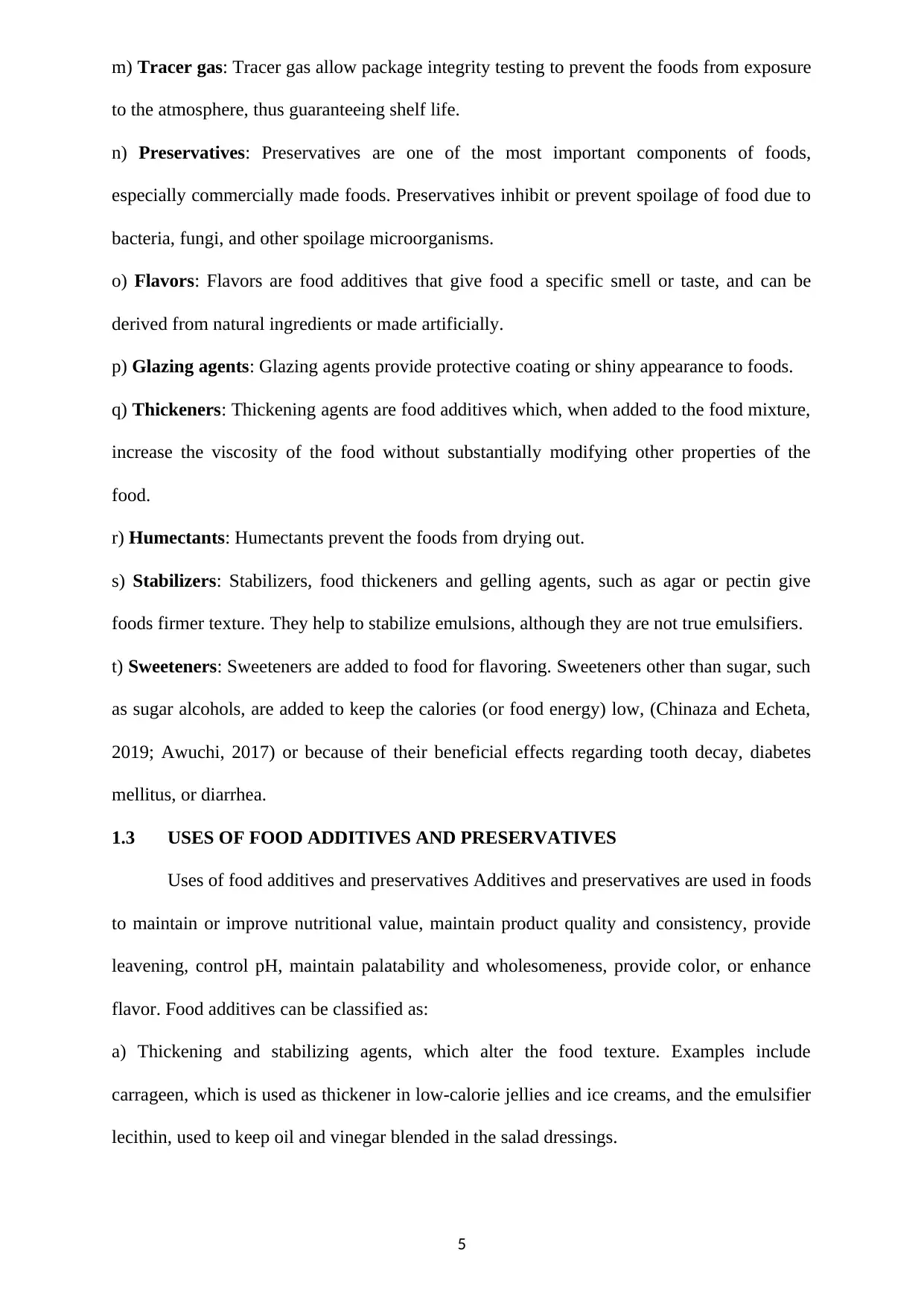
m) Tracer gas: Tracer gas allow package integrity testing to prevent the foods from exposure
to the atmosphere, thus guaranteeing shelf life.
n) Preservatives: Preservatives are one of the most important components of foods,
especially commercially made foods. Preservatives inhibit or prevent spoilage of food due to
bacteria, fungi, and other spoilage microorganisms.
o) Flavors: Flavors are food additives that give food a specific smell or taste, and can be
derived from natural ingredients or made artificially.
p) Glazing agents: Glazing agents provide protective coating or shiny appearance to foods.
q) Thickeners: Thickening agents are food additives which, when added to the food mixture,
increase the viscosity of the food without substantially modifying other properties of the
food.
r) Humectants: Humectants prevent the foods from drying out.
s) Stabilizers: Stabilizers, food thickeners and gelling agents, such as agar or pectin give
foods firmer texture. They help to stabilize emulsions, although they are not true emulsifiers.
t) Sweeteners: Sweeteners are added to food for flavoring. Sweeteners other than sugar, such
as sugar alcohols, are added to keep the calories (or food energy) low, (Chinaza and Echeta,
2019; Awuchi, 2017) or because of their beneficial effects regarding tooth decay, diabetes
mellitus, or diarrhea.
1.3 USES OF FOOD ADDITIVES AND PRESERVATIVES
Uses of food additives and preservatives Additives and preservatives are used in foods
to maintain or improve nutritional value, maintain product quality and consistency, provide
leavening, control pH, maintain palatability and wholesomeness, provide color, or enhance
flavor. Food additives can be classified as:
a) Thickening and stabilizing agents, which alter the food texture. Examples include
carrageen, which is used as thickener in low-calorie jellies and ice creams, and the emulsifier
lecithin, used to keep oil and vinegar blended in the salad dressings.
5
to the atmosphere, thus guaranteeing shelf life.
n) Preservatives: Preservatives are one of the most important components of foods,
especially commercially made foods. Preservatives inhibit or prevent spoilage of food due to
bacteria, fungi, and other spoilage microorganisms.
o) Flavors: Flavors are food additives that give food a specific smell or taste, and can be
derived from natural ingredients or made artificially.
p) Glazing agents: Glazing agents provide protective coating or shiny appearance to foods.
q) Thickeners: Thickening agents are food additives which, when added to the food mixture,
increase the viscosity of the food without substantially modifying other properties of the
food.
r) Humectants: Humectants prevent the foods from drying out.
s) Stabilizers: Stabilizers, food thickeners and gelling agents, such as agar or pectin give
foods firmer texture. They help to stabilize emulsions, although they are not true emulsifiers.
t) Sweeteners: Sweeteners are added to food for flavoring. Sweeteners other than sugar, such
as sugar alcohols, are added to keep the calories (or food energy) low, (Chinaza and Echeta,
2019; Awuchi, 2017) or because of their beneficial effects regarding tooth decay, diabetes
mellitus, or diarrhea.
1.3 USES OF FOOD ADDITIVES AND PRESERVATIVES
Uses of food additives and preservatives Additives and preservatives are used in foods
to maintain or improve nutritional value, maintain product quality and consistency, provide
leavening, control pH, maintain palatability and wholesomeness, provide color, or enhance
flavor. Food additives can be classified as:
a) Thickening and stabilizing agents, which alter the food texture. Examples include
carrageen, which is used as thickener in low-calorie jellies and ice creams, and the emulsifier
lecithin, used to keep oil and vinegar blended in the salad dressings.
5
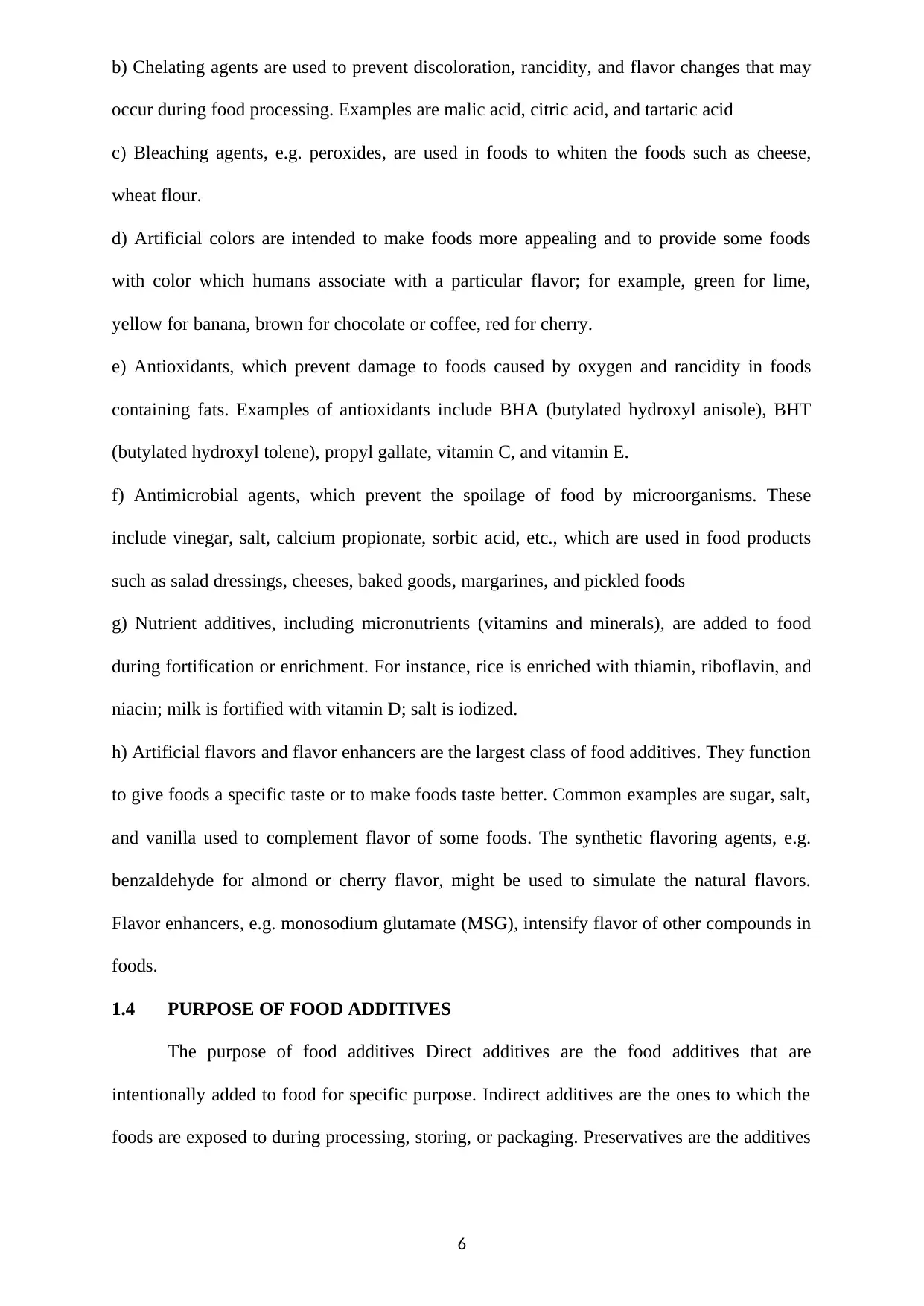
b) Chelating agents are used to prevent discoloration, rancidity, and flavor changes that may
occur during food processing. Examples are malic acid, citric acid, and tartaric acid
c) Bleaching agents, e.g. peroxides, are used in foods to whiten the foods such as cheese,
wheat flour.
d) Artificial colors are intended to make foods more appealing and to provide some foods
with color which humans associate with a particular flavor; for example, green for lime,
yellow for banana, brown for chocolate or coffee, red for cherry.
e) Antioxidants, which prevent damage to foods caused by oxygen and rancidity in foods
containing fats. Examples of antioxidants include BHA (butylated hydroxyl anisole), BHT
(butylated hydroxyl tolene), propyl gallate, vitamin C, and vitamin E.
f) Antimicrobial agents, which prevent the spoilage of food by microorganisms. These
include vinegar, salt, calcium propionate, sorbic acid, etc., which are used in food products
such as salad dressings, cheeses, baked goods, margarines, and pickled foods
g) Nutrient additives, including micronutrients (vitamins and minerals), are added to food
during fortification or enrichment. For instance, rice is enriched with thiamin, riboflavin, and
niacin; milk is fortified with vitamin D; salt is iodized.
h) Artificial flavors and flavor enhancers are the largest class of food additives. They function
to give foods a specific taste or to make foods taste better. Common examples are sugar, salt,
and vanilla used to complement flavor of some foods. The synthetic flavoring agents, e.g.
benzaldehyde for almond or cherry flavor, might be used to simulate the natural flavors.
Flavor enhancers, e.g. monosodium glutamate (MSG), intensify flavor of other compounds in
foods.
1.4 PURPOSE OF FOOD ADDITIVES
The purpose of food additives Direct additives are the food additives that are
intentionally added to food for specific purpose. Indirect additives are the ones to which the
foods are exposed to during processing, storing, or packaging. Preservatives are the additives
6
occur during food processing. Examples are malic acid, citric acid, and tartaric acid
c) Bleaching agents, e.g. peroxides, are used in foods to whiten the foods such as cheese,
wheat flour.
d) Artificial colors are intended to make foods more appealing and to provide some foods
with color which humans associate with a particular flavor; for example, green for lime,
yellow for banana, brown for chocolate or coffee, red for cherry.
e) Antioxidants, which prevent damage to foods caused by oxygen and rancidity in foods
containing fats. Examples of antioxidants include BHA (butylated hydroxyl anisole), BHT
(butylated hydroxyl tolene), propyl gallate, vitamin C, and vitamin E.
f) Antimicrobial agents, which prevent the spoilage of food by microorganisms. These
include vinegar, salt, calcium propionate, sorbic acid, etc., which are used in food products
such as salad dressings, cheeses, baked goods, margarines, and pickled foods
g) Nutrient additives, including micronutrients (vitamins and minerals), are added to food
during fortification or enrichment. For instance, rice is enriched with thiamin, riboflavin, and
niacin; milk is fortified with vitamin D; salt is iodized.
h) Artificial flavors and flavor enhancers are the largest class of food additives. They function
to give foods a specific taste or to make foods taste better. Common examples are sugar, salt,
and vanilla used to complement flavor of some foods. The synthetic flavoring agents, e.g.
benzaldehyde for almond or cherry flavor, might be used to simulate the natural flavors.
Flavor enhancers, e.g. monosodium glutamate (MSG), intensify flavor of other compounds in
foods.
1.4 PURPOSE OF FOOD ADDITIVES
The purpose of food additives Direct additives are the food additives that are
intentionally added to food for specific purpose. Indirect additives are the ones to which the
foods are exposed to during processing, storing, or packaging. Preservatives are the additives
6
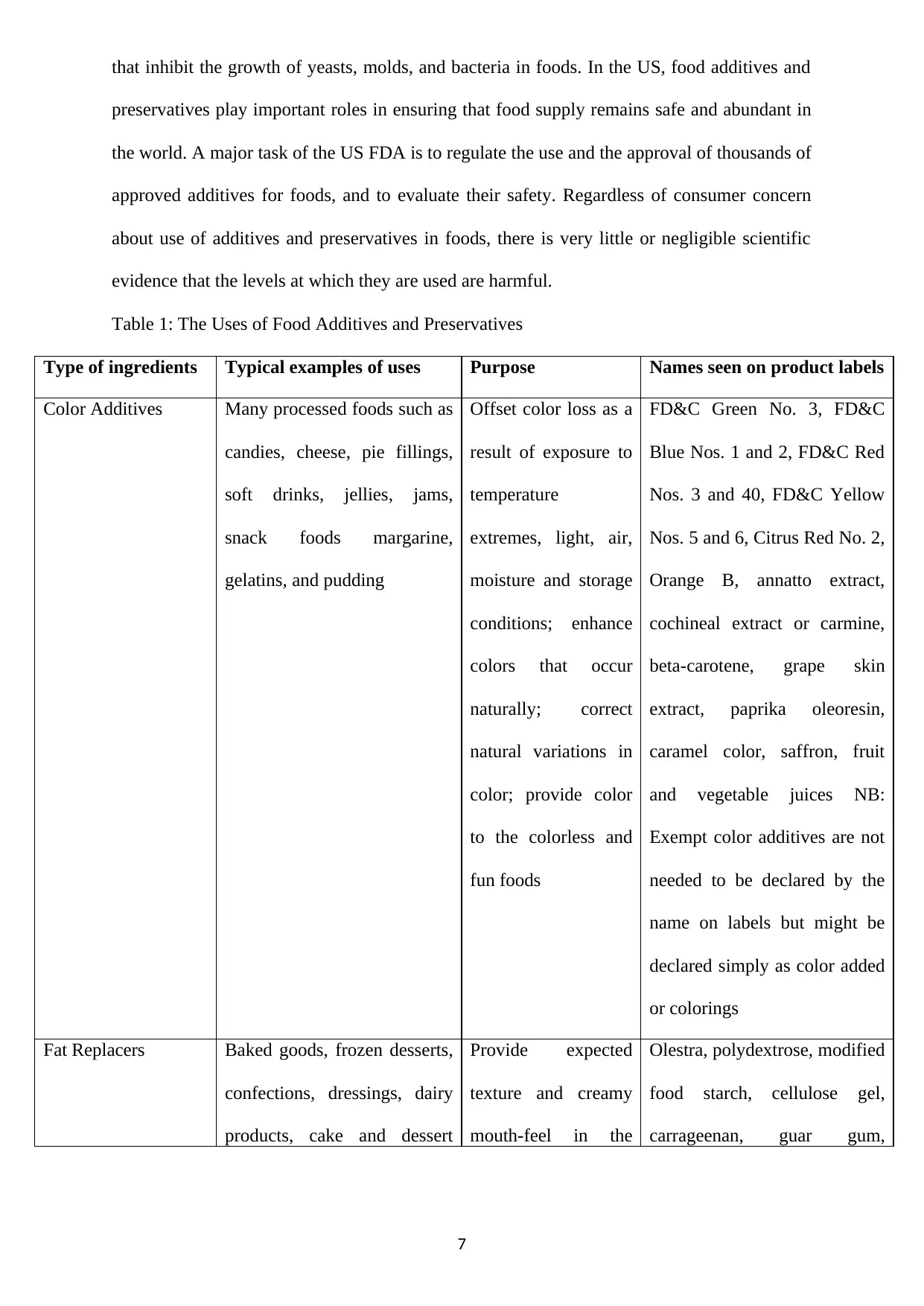
that inhibit the growth of yeasts, molds, and bacteria in foods. In the US, food additives and
preservatives play important roles in ensuring that food supply remains safe and abundant in
the world. A major task of the US FDA is to regulate the use and the approval of thousands of
approved additives for foods, and to evaluate their safety. Regardless of consumer concern
about use of additives and preservatives in foods, there is very little or negligible scientific
evidence that the levels at which they are used are harmful.
Table 1: The Uses of Food Additives and Preservatives
Type of ingredients Typical examples of uses Purpose Names seen on product labels
Color Additives Many processed foods such as
candies, cheese, pie fillings,
soft drinks, jellies, jams,
snack foods margarine,
gelatins, and pudding
Offset color loss as a
result of exposure to
temperature
extremes, light, air,
moisture and storage
conditions; enhance
colors that occur
naturally; correct
natural variations in
color; provide color
to the colorless and
fun foods
FD&C Green No. 3, FD&C
Blue Nos. 1 and 2, FD&C Red
Nos. 3 and 40, FD&C Yellow
Nos. 5 and 6, Citrus Red No. 2,
Orange B, annatto extract,
cochineal extract or carmine,
beta-carotene, grape skin
extract, paprika oleoresin,
caramel color, saffron, fruit
and vegetable juices NB:
Exempt color additives are not
needed to be declared by the
name on labels but might be
declared simply as color added
or colorings
Fat Replacers Baked goods, frozen desserts,
confections, dressings, dairy
products, cake and dessert
Provide expected
texture and creamy
mouth-feel in the
Olestra, polydextrose, modified
food starch, cellulose gel,
carrageenan, guar gum,
7
preservatives play important roles in ensuring that food supply remains safe and abundant in
the world. A major task of the US FDA is to regulate the use and the approval of thousands of
approved additives for foods, and to evaluate their safety. Regardless of consumer concern
about use of additives and preservatives in foods, there is very little or negligible scientific
evidence that the levels at which they are used are harmful.
Table 1: The Uses of Food Additives and Preservatives
Type of ingredients Typical examples of uses Purpose Names seen on product labels
Color Additives Many processed foods such as
candies, cheese, pie fillings,
soft drinks, jellies, jams,
snack foods margarine,
gelatins, and pudding
Offset color loss as a
result of exposure to
temperature
extremes, light, air,
moisture and storage
conditions; enhance
colors that occur
naturally; correct
natural variations in
color; provide color
to the colorless and
fun foods
FD&C Green No. 3, FD&C
Blue Nos. 1 and 2, FD&C Red
Nos. 3 and 40, FD&C Yellow
Nos. 5 and 6, Citrus Red No. 2,
Orange B, annatto extract,
cochineal extract or carmine,
beta-carotene, grape skin
extract, paprika oleoresin,
caramel color, saffron, fruit
and vegetable juices NB:
Exempt color additives are not
needed to be declared by the
name on labels but might be
declared simply as color added
or colorings
Fat Replacers Baked goods, frozen desserts,
confections, dressings, dairy
products, cake and dessert
Provide expected
texture and creamy
mouth-feel in the
Olestra, polydextrose, modified
food starch, cellulose gel,
carrageenan, guar gum,
7
Paraphrase This Document
Need a fresh take? Get an instant paraphrase of this document with our AI Paraphraser

mixes reduced-fat foods xanthan gum, micro-
particulated egg white protein,
whey protein concentrate
Flavor Enhancers Many processed foods Enhance flavors
already present in
food (not providing
their own separate
flavor)
Monosodium glutamate
(MSG), autolyzed yeast
extract, hydrolyzed soy
protein, disodium guanylate or
inosinate
Flavors and Spices Gelatin dessert mixes,
pudding and pie fillings, cake
mixes, candies, soft drinks,
ice cream, salad dressings,
BBQ sauce
Add specific flavors
(both natural and
synthetic)
Natural flavoring, spices, and
artificial flavor
Preservatives Fruit sauces and jellies, baked
goods, cured meats,
beverages, oils and
margarines, dressings, snack
foods, cereals, fruits and
vegetables
Prevent food spoilage
from molds, fungi,
bacteria, or yeast
(antimicrobials);
maintain freshness;
prevent or slow
changes in color,
texture, or flavor, and
delay rancidity
(antioxidants)
Ascorbic acid, citric acid,
calcium propionate, sodium
erythorbate, sodium benzoate,
sodium nitrite, calcium sorbate,
BHA, BHT, EDTA, potassium
sorbate, tocopherols (Vitamin
E)
Sweeteners Beverages, baked goods,
table-top sugar, confections,
Add sweetness with
or without extra
Sucrose (sugar), fructose,
glucose, sorbitol, mannitol,
8
particulated egg white protein,
whey protein concentrate
Flavor Enhancers Many processed foods Enhance flavors
already present in
food (not providing
their own separate
flavor)
Monosodium glutamate
(MSG), autolyzed yeast
extract, hydrolyzed soy
protein, disodium guanylate or
inosinate
Flavors and Spices Gelatin dessert mixes,
pudding and pie fillings, cake
mixes, candies, soft drinks,
ice cream, salad dressings,
BBQ sauce
Add specific flavors
(both natural and
synthetic)
Natural flavoring, spices, and
artificial flavor
Preservatives Fruit sauces and jellies, baked
goods, cured meats,
beverages, oils and
margarines, dressings, snack
foods, cereals, fruits and
vegetables
Prevent food spoilage
from molds, fungi,
bacteria, or yeast
(antimicrobials);
maintain freshness;
prevent or slow
changes in color,
texture, or flavor, and
delay rancidity
(antioxidants)
Ascorbic acid, citric acid,
calcium propionate, sodium
erythorbate, sodium benzoate,
sodium nitrite, calcium sorbate,
BHA, BHT, EDTA, potassium
sorbate, tocopherols (Vitamin
E)
Sweeteners Beverages, baked goods,
table-top sugar, confections,
Add sweetness with
or without extra
Sucrose (sugar), fructose,
glucose, sorbitol, mannitol,
8

substitutes, many processed
foods
calories high fructose corn syrup,
sucralose, corn syrup,
saccharin, aspartame, neotame,
acesulfame potassium
(acesulfame-K)
9
foods
calories high fructose corn syrup,
sucralose, corn syrup,
saccharin, aspartame, neotame,
acesulfame potassium
(acesulfame-K)
9
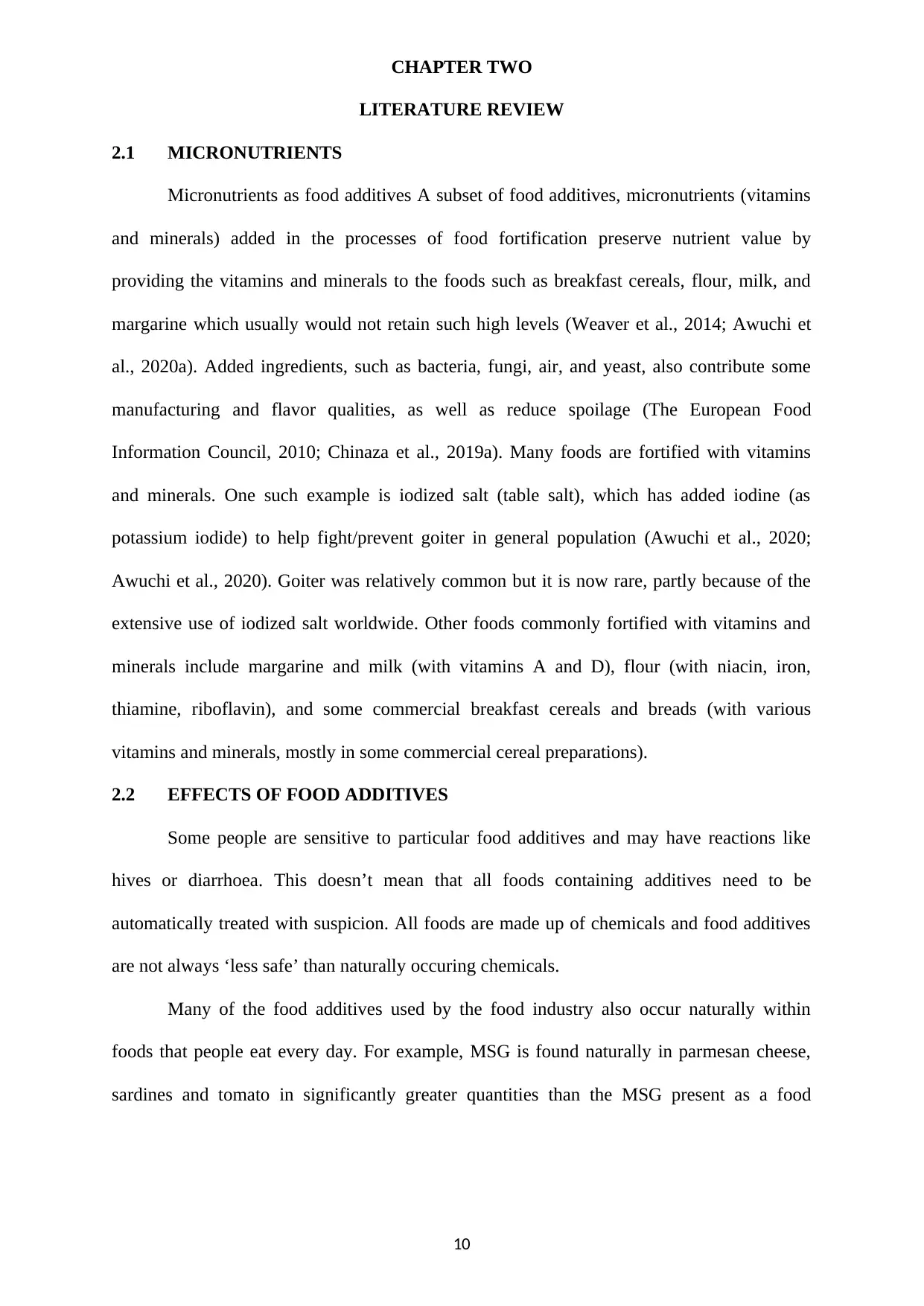
CHAPTER TWO
LITERATURE REVIEW
2.1 MICRONUTRIENTS
Micronutrients as food additives A subset of food additives, micronutrients (vitamins
and minerals) added in the processes of food fortification preserve nutrient value by
providing the vitamins and minerals to the foods such as breakfast cereals, flour, milk, and
margarine which usually would not retain such high levels (Weaver et al., 2014; Awuchi et
al., 2020a). Added ingredients, such as bacteria, fungi, air, and yeast, also contribute some
manufacturing and flavor qualities, as well as reduce spoilage (The European Food
Information Council, 2010; Chinaza et al., 2019a). Many foods are fortified with vitamins
and minerals. One such example is iodized salt (table salt), which has added iodine (as
potassium iodide) to help fight/prevent goiter in general population (Awuchi et al., 2020;
Awuchi et al., 2020). Goiter was relatively common but it is now rare, partly because of the
extensive use of iodized salt worldwide. Other foods commonly fortified with vitamins and
minerals include margarine and milk (with vitamins A and D), flour (with niacin, iron,
thiamine, riboflavin), and some commercial breakfast cereals and breads (with various
vitamins and minerals, mostly in some commercial cereal preparations).
2.2 EFFECTS OF FOOD ADDITIVES
Some people are sensitive to particular food additives and may have reactions like
hives or diarrhoea. This doesn’t mean that all foods containing additives need to be
automatically treated with suspicion. All foods are made up of chemicals and food additives
are not always ‘less safe’ than naturally occuring chemicals.
Many of the food additives used by the food industry also occur naturally within
foods that people eat every day. For example, MSG is found naturally in parmesan cheese,
sardines and tomato in significantly greater quantities than the MSG present as a food
10
LITERATURE REVIEW
2.1 MICRONUTRIENTS
Micronutrients as food additives A subset of food additives, micronutrients (vitamins
and minerals) added in the processes of food fortification preserve nutrient value by
providing the vitamins and minerals to the foods such as breakfast cereals, flour, milk, and
margarine which usually would not retain such high levels (Weaver et al., 2014; Awuchi et
al., 2020a). Added ingredients, such as bacteria, fungi, air, and yeast, also contribute some
manufacturing and flavor qualities, as well as reduce spoilage (The European Food
Information Council, 2010; Chinaza et al., 2019a). Many foods are fortified with vitamins
and minerals. One such example is iodized salt (table salt), which has added iodine (as
potassium iodide) to help fight/prevent goiter in general population (Awuchi et al., 2020;
Awuchi et al., 2020). Goiter was relatively common but it is now rare, partly because of the
extensive use of iodized salt worldwide. Other foods commonly fortified with vitamins and
minerals include margarine and milk (with vitamins A and D), flour (with niacin, iron,
thiamine, riboflavin), and some commercial breakfast cereals and breads (with various
vitamins and minerals, mostly in some commercial cereal preparations).
2.2 EFFECTS OF FOOD ADDITIVES
Some people are sensitive to particular food additives and may have reactions like
hives or diarrhoea. This doesn’t mean that all foods containing additives need to be
automatically treated with suspicion. All foods are made up of chemicals and food additives
are not always ‘less safe’ than naturally occuring chemicals.
Many of the food additives used by the food industry also occur naturally within
foods that people eat every day. For example, MSG is found naturally in parmesan cheese,
sardines and tomato in significantly greater quantities than the MSG present as a food
10
Secure Best Marks with AI Grader
Need help grading? Try our AI Grader for instant feedback on your assignments.

additive. People with food allergies and intolerances are also often sensitive to chemicals
found naturally in certain foods, such as nuts or shellfish.
Many people view food additives as a major food threat. However, in terms of health
risk, food additives would come in at the end of the line, after food-borne microorganisms
(like salmonella), inappropriate hygiene and eating habits, environmental contaminants and
naturally occurring toxins.
2.3 SOME FOOD ADDITIVES THAT CAUSE REACTION
For most people, additives are not a problem in the short term. However, 50 of the
400 currently approved additives in Australia have been associated with adverse reactions in
some people. Some food additives are more likely than others to cause reactions in sensitive
people.
It is often the additives that are used to give a food a marketable quality, such as colour, that
most commonly cause allergic reactions. Some of these hypersensitive reactions include:
i. Digestive disorders – diarrhoea and colicky pains
ii. Nervous disorders – hyperactivity, insomnia and irritability
iii. Respiratory problems – asthma, rhinitis and sinusitis
iv. Skin problems – hives, itching, rashes and swelling.
It is important to realize that many of the symptoms experienced as a result of food
sensitivities can be caused by other disorders. Medical diagnosis is important. If you try to
diagnose yourself, you may restrict your diet unnecessarily and neglect an illness.
2.4 PRESERVATION OF FOOD
Food spoilage is the process of food becoming unsafe or unacceptable for human
consumption. Spoilage is normally caused by the growth of microorganisms in foods. Other
losses in quality are caused by natural activities in fresh food tissues, for example, the
excessive softening in overripe fruit caused by fruit enzymes. Spoilage and quality losses
11
found naturally in certain foods, such as nuts or shellfish.
Many people view food additives as a major food threat. However, in terms of health
risk, food additives would come in at the end of the line, after food-borne microorganisms
(like salmonella), inappropriate hygiene and eating habits, environmental contaminants and
naturally occurring toxins.
2.3 SOME FOOD ADDITIVES THAT CAUSE REACTION
For most people, additives are not a problem in the short term. However, 50 of the
400 currently approved additives in Australia have been associated with adverse reactions in
some people. Some food additives are more likely than others to cause reactions in sensitive
people.
It is often the additives that are used to give a food a marketable quality, such as colour, that
most commonly cause allergic reactions. Some of these hypersensitive reactions include:
i. Digestive disorders – diarrhoea and colicky pains
ii. Nervous disorders – hyperactivity, insomnia and irritability
iii. Respiratory problems – asthma, rhinitis and sinusitis
iv. Skin problems – hives, itching, rashes and swelling.
It is important to realize that many of the symptoms experienced as a result of food
sensitivities can be caused by other disorders. Medical diagnosis is important. If you try to
diagnose yourself, you may restrict your diet unnecessarily and neglect an illness.
2.4 PRESERVATION OF FOOD
Food spoilage is the process of food becoming unsafe or unacceptable for human
consumption. Spoilage is normally caused by the growth of microorganisms in foods. Other
losses in quality are caused by natural activities in fresh food tissues, for example, the
excessive softening in overripe fruit caused by fruit enzymes. Spoilage and quality losses
11
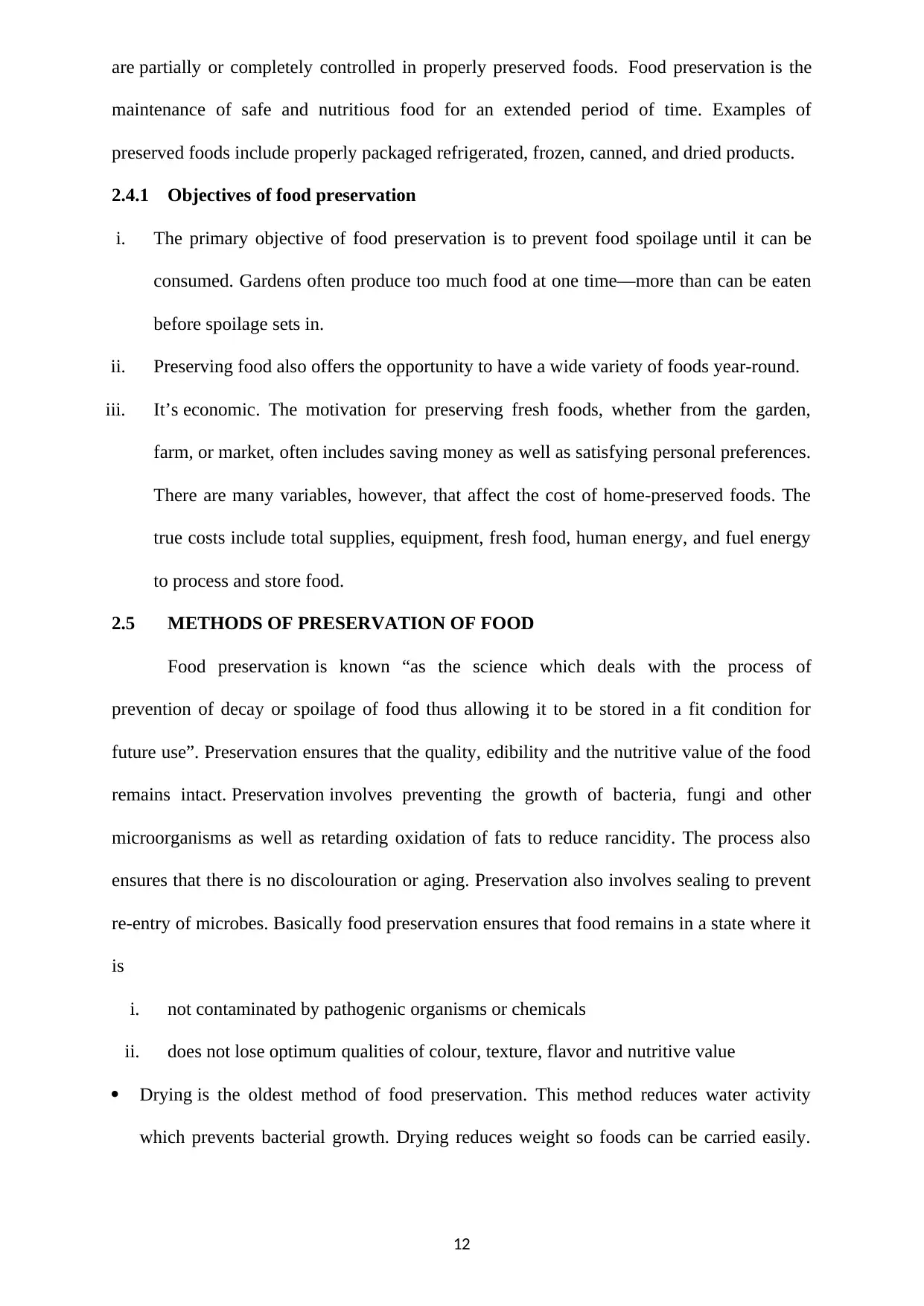
are partially or completely controlled in properly preserved foods. Food preservation is the
maintenance of safe and nutritious food for an extended period of time. Examples of
preserved foods include properly packaged refrigerated, frozen, canned, and dried products.
2.4.1 Objectives of food preservation
i. The primary objective of food preservation is to prevent food spoilage until it can be
consumed. Gardens often produce too much food at one time—more than can be eaten
before spoilage sets in.
ii. Preserving food also offers the opportunity to have a wide variety of foods year-round.
iii. It’s economic. The motivation for preserving fresh foods, whether from the garden,
farm, or market, often includes saving money as well as satisfying personal preferences.
There are many variables, however, that affect the cost of home-preserved foods. The
true costs include total supplies, equipment, fresh food, human energy, and fuel energy
to process and store food.
2.5 METHODS OF PRESERVATION OF FOOD
Food preservation is known “as the science which deals with the process of
prevention of decay or spoilage of food thus allowing it to be stored in a fit condition for
future use”. Preservation ensures that the quality, edibility and the nutritive value of the food
remains intact. Preservation involves preventing the growth of bacteria, fungi and other
microorganisms as well as retarding oxidation of fats to reduce rancidity. The process also
ensures that there is no discolouration or aging. Preservation also involves sealing to prevent
re-entry of microbes. Basically food preservation ensures that food remains in a state where it
is
i. not contaminated by pathogenic organisms or chemicals
ii. does not lose optimum qualities of colour, texture, flavor and nutritive value
Drying is the oldest method of food preservation. This method reduces water activity
which prevents bacterial growth. Drying reduces weight so foods can be carried easily.
12
maintenance of safe and nutritious food for an extended period of time. Examples of
preserved foods include properly packaged refrigerated, frozen, canned, and dried products.
2.4.1 Objectives of food preservation
i. The primary objective of food preservation is to prevent food spoilage until it can be
consumed. Gardens often produce too much food at one time—more than can be eaten
before spoilage sets in.
ii. Preserving food also offers the opportunity to have a wide variety of foods year-round.
iii. It’s economic. The motivation for preserving fresh foods, whether from the garden,
farm, or market, often includes saving money as well as satisfying personal preferences.
There are many variables, however, that affect the cost of home-preserved foods. The
true costs include total supplies, equipment, fresh food, human energy, and fuel energy
to process and store food.
2.5 METHODS OF PRESERVATION OF FOOD
Food preservation is known “as the science which deals with the process of
prevention of decay or spoilage of food thus allowing it to be stored in a fit condition for
future use”. Preservation ensures that the quality, edibility and the nutritive value of the food
remains intact. Preservation involves preventing the growth of bacteria, fungi and other
microorganisms as well as retarding oxidation of fats to reduce rancidity. The process also
ensures that there is no discolouration or aging. Preservation also involves sealing to prevent
re-entry of microbes. Basically food preservation ensures that food remains in a state where it
is
i. not contaminated by pathogenic organisms or chemicals
ii. does not lose optimum qualities of colour, texture, flavor and nutritive value
Drying is the oldest method of food preservation. This method reduces water activity
which prevents bacterial growth. Drying reduces weight so foods can be carried easily.
12
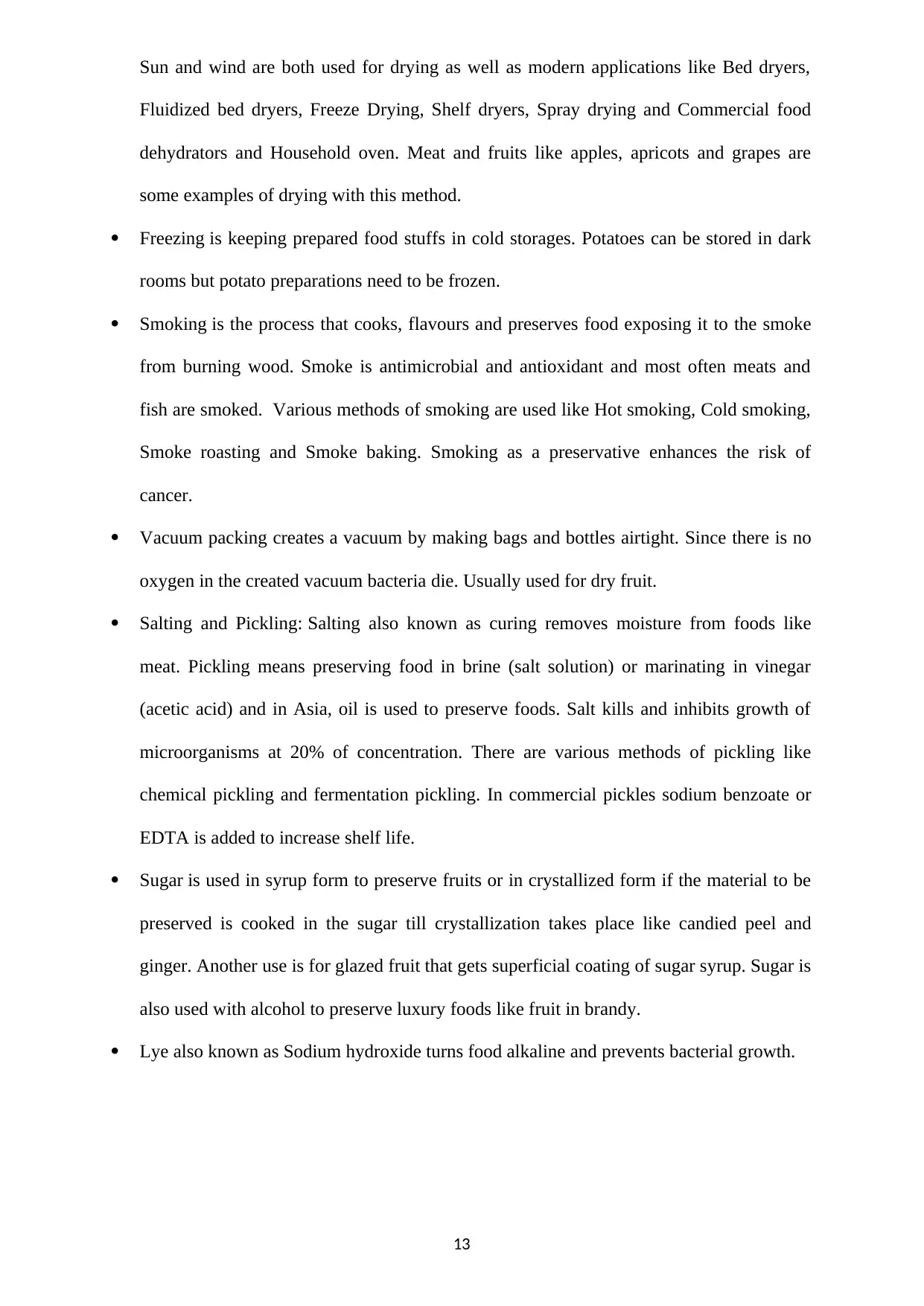
Sun and wind are both used for drying as well as modern applications like Bed dryers,
Fluidized bed dryers, Freeze Drying, Shelf dryers, Spray drying and Commercial food
dehydrators and Household oven. Meat and fruits like apples, apricots and grapes are
some examples of drying with this method.
Freezing is keeping prepared food stuffs in cold storages. Potatoes can be stored in dark
rooms but potato preparations need to be frozen.
Smoking is the process that cooks, flavours and preserves food exposing it to the smoke
from burning wood. Smoke is antimicrobial and antioxidant and most often meats and
fish are smoked. Various methods of smoking are used like Hot smoking, Cold smoking,
Smoke roasting and Smoke baking. Smoking as a preservative enhances the risk of
cancer.
Vacuum packing creates a vacuum by making bags and bottles airtight. Since there is no
oxygen in the created vacuum bacteria die. Usually used for dry fruit.
Salting and Pickling: Salting also known as curing removes moisture from foods like
meat. Pickling means preserving food in brine (salt solution) or marinating in vinegar
(acetic acid) and in Asia, oil is used to preserve foods. Salt kills and inhibits growth of
microorganisms at 20% of concentration. There are various methods of pickling like
chemical pickling and fermentation pickling. In commercial pickles sodium benzoate or
EDTA is added to increase shelf life.
Sugar is used in syrup form to preserve fruits or in crystallized form if the material to be
preserved is cooked in the sugar till crystallization takes place like candied peel and
ginger. Another use is for glazed fruit that gets superficial coating of sugar syrup. Sugar is
also used with alcohol to preserve luxury foods like fruit in brandy.
Lye also known as Sodium hydroxide turns food alkaline and prevents bacterial growth.
13
Fluidized bed dryers, Freeze Drying, Shelf dryers, Spray drying and Commercial food
dehydrators and Household oven. Meat and fruits like apples, apricots and grapes are
some examples of drying with this method.
Freezing is keeping prepared food stuffs in cold storages. Potatoes can be stored in dark
rooms but potato preparations need to be frozen.
Smoking is the process that cooks, flavours and preserves food exposing it to the smoke
from burning wood. Smoke is antimicrobial and antioxidant and most often meats and
fish are smoked. Various methods of smoking are used like Hot smoking, Cold smoking,
Smoke roasting and Smoke baking. Smoking as a preservative enhances the risk of
cancer.
Vacuum packing creates a vacuum by making bags and bottles airtight. Since there is no
oxygen in the created vacuum bacteria die. Usually used for dry fruit.
Salting and Pickling: Salting also known as curing removes moisture from foods like
meat. Pickling means preserving food in brine (salt solution) or marinating in vinegar
(acetic acid) and in Asia, oil is used to preserve foods. Salt kills and inhibits growth of
microorganisms at 20% of concentration. There are various methods of pickling like
chemical pickling and fermentation pickling. In commercial pickles sodium benzoate or
EDTA is added to increase shelf life.
Sugar is used in syrup form to preserve fruits or in crystallized form if the material to be
preserved is cooked in the sugar till crystallization takes place like candied peel and
ginger. Another use is for glazed fruit that gets superficial coating of sugar syrup. Sugar is
also used with alcohol to preserve luxury foods like fruit in brandy.
Lye also known as Sodium hydroxide turns food alkaline and prevents bacterial growth.
13
Paraphrase This Document
Need a fresh take? Get an instant paraphrase of this document with our AI Paraphraser

Canning and bottling means sealing cooked food in sterile bottles and cans. The container
is boiled and this kills or weakens bacteria. Foods are cooked for various lengths or time.
Once the can or bottle is opened the food is again at risk of spoilage.
Jellying is preserving food by cooking in a material that solidifies to form a gel. Fruits are
generally preserved as jelly, marmalade or fruit preserves and the jellying agent is pectin
that is naturally found in fruit. Sugar is also added.
Potting is a traditional British way of preserving meat by placing it in a pot and sealing it
with a layer of fat.
Jugging is preserving meat by stewing it in an earthenware jug or casserole. Brine or wine
is used to stew meat in and sometimes the animal’s blood.
Burial in the ground preserves food as there is lack of light and oxygen and it has cool
temperatures, pH level, or desiccants in the soil. Used to preserve cabbages and root
vegetables.
Pulsed Electric Field Processing is a new method of preservation that uses brief pulses as
strong electric field to process cells. This is still at an experimental stage.
Modified atmosphere preserves food by operating on the atmosphere around it. Salad
crops that are difficult to preserve are packaged in sealed bags with an atmosphere
modified to reduce the oxygen concentration and increase the carbon dioxide
concentration.
Controlled use of organism is used on cheese, wine and beer as they are preserved for a
longer time. This method uses benign organisms to preserve food by introducing them to
food where they make an environment which is not suitable for harmful pathogens to
grow.
High pressure food preservation is a method that presses foods inside a vessel by exerting
70,000 pounds per square inch or more of pressure. This disables microorganisms and
prevents spoilage but food retains its appearance, texture and flavour.
14
is boiled and this kills or weakens bacteria. Foods are cooked for various lengths or time.
Once the can or bottle is opened the food is again at risk of spoilage.
Jellying is preserving food by cooking in a material that solidifies to form a gel. Fruits are
generally preserved as jelly, marmalade or fruit preserves and the jellying agent is pectin
that is naturally found in fruit. Sugar is also added.
Potting is a traditional British way of preserving meat by placing it in a pot and sealing it
with a layer of fat.
Jugging is preserving meat by stewing it in an earthenware jug or casserole. Brine or wine
is used to stew meat in and sometimes the animal’s blood.
Burial in the ground preserves food as there is lack of light and oxygen and it has cool
temperatures, pH level, or desiccants in the soil. Used to preserve cabbages and root
vegetables.
Pulsed Electric Field Processing is a new method of preservation that uses brief pulses as
strong electric field to process cells. This is still at an experimental stage.
Modified atmosphere preserves food by operating on the atmosphere around it. Salad
crops that are difficult to preserve are packaged in sealed bags with an atmosphere
modified to reduce the oxygen concentration and increase the carbon dioxide
concentration.
Controlled use of organism is used on cheese, wine and beer as they are preserved for a
longer time. This method uses benign organisms to preserve food by introducing them to
food where they make an environment which is not suitable for harmful pathogens to
grow.
High pressure food preservation is a method that presses foods inside a vessel by exerting
70,000 pounds per square inch or more of pressure. This disables microorganisms and
prevents spoilage but food retains its appearance, texture and flavour.
14
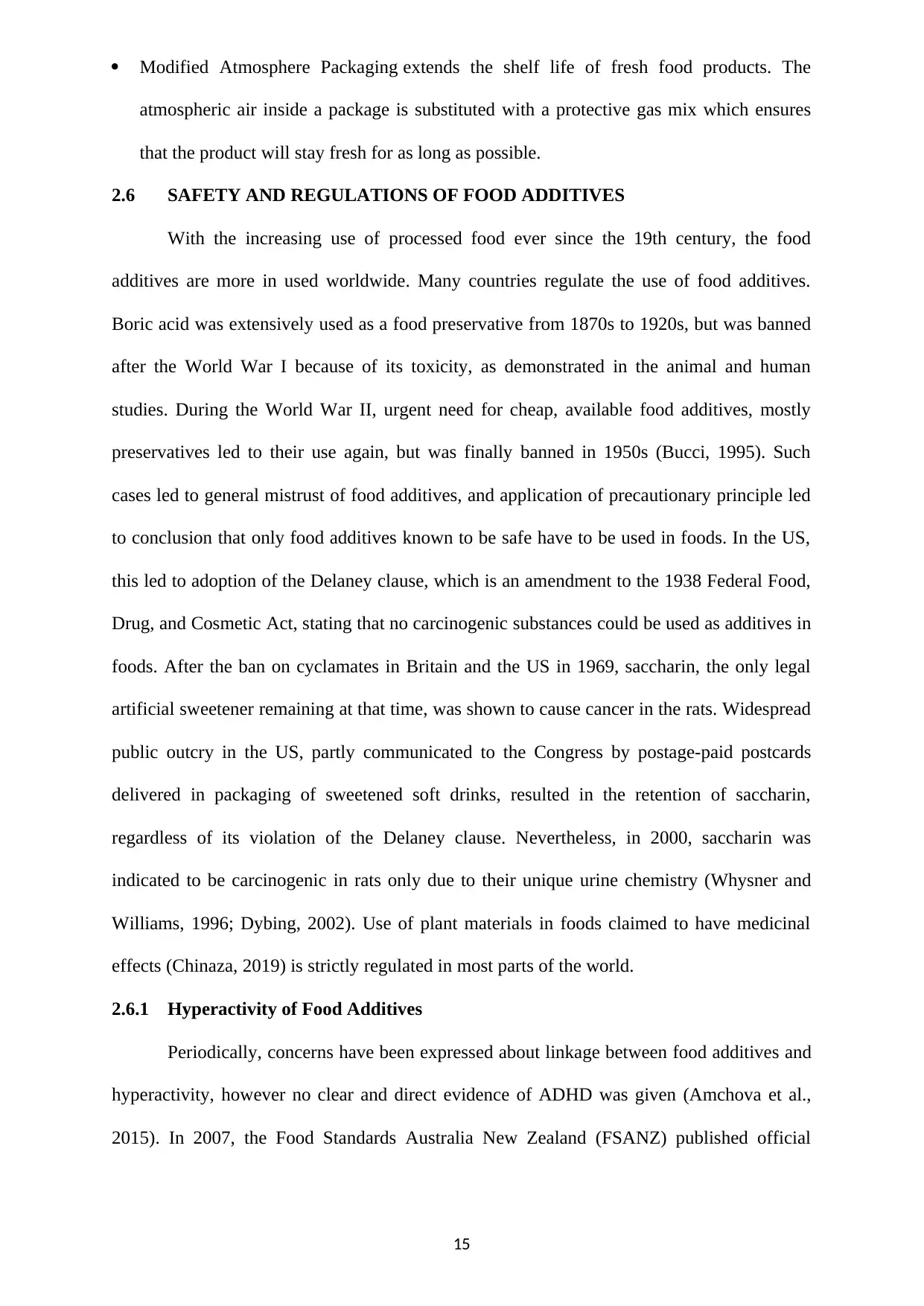
Modified Atmosphere Packaging extends the shelf life of fresh food products. The
atmospheric air inside a package is substituted with a protective gas mix which ensures
that the product will stay fresh for as long as possible.
2.6 SAFETY AND REGULATIONS OF FOOD ADDITIVES
With the increasing use of processed food ever since the 19th century, the food
additives are more in used worldwide. Many countries regulate the use of food additives.
Boric acid was extensively used as a food preservative from 1870s to 1920s, but was banned
after the World War I because of its toxicity, as demonstrated in the animal and human
studies. During the World War II, urgent need for cheap, available food additives, mostly
preservatives led to their use again, but was finally banned in 1950s (Bucci, 1995). Such
cases led to general mistrust of food additives, and application of precautionary principle led
to conclusion that only food additives known to be safe have to be used in foods. In the US,
this led to adoption of the Delaney clause, which is an amendment to the 1938 Federal Food,
Drug, and Cosmetic Act, stating that no carcinogenic substances could be used as additives in
foods. After the ban on cyclamates in Britain and the US in 1969, saccharin, the only legal
artificial sweetener remaining at that time, was shown to cause cancer in the rats. Widespread
public outcry in the US, partly communicated to the Congress by postage-paid postcards
delivered in packaging of sweetened soft drinks, resulted in the retention of saccharin,
regardless of its violation of the Delaney clause. Nevertheless, in 2000, saccharin was
indicated to be carcinogenic in rats only due to their unique urine chemistry (Whysner and
Williams, 1996; Dybing, 2002). Use of plant materials in foods claimed to have medicinal
effects (Chinaza, 2019) is strictly regulated in most parts of the world.
2.6.1 Hyperactivity of Food Additives
Periodically, concerns have been expressed about linkage between food additives and
hyperactivity, however no clear and direct evidence of ADHD was given (Amchova et al.,
2015). In 2007, the Food Standards Australia New Zealand (FSANZ) published official
15
atmospheric air inside a package is substituted with a protective gas mix which ensures
that the product will stay fresh for as long as possible.
2.6 SAFETY AND REGULATIONS OF FOOD ADDITIVES
With the increasing use of processed food ever since the 19th century, the food
additives are more in used worldwide. Many countries regulate the use of food additives.
Boric acid was extensively used as a food preservative from 1870s to 1920s, but was banned
after the World War I because of its toxicity, as demonstrated in the animal and human
studies. During the World War II, urgent need for cheap, available food additives, mostly
preservatives led to their use again, but was finally banned in 1950s (Bucci, 1995). Such
cases led to general mistrust of food additives, and application of precautionary principle led
to conclusion that only food additives known to be safe have to be used in foods. In the US,
this led to adoption of the Delaney clause, which is an amendment to the 1938 Federal Food,
Drug, and Cosmetic Act, stating that no carcinogenic substances could be used as additives in
foods. After the ban on cyclamates in Britain and the US in 1969, saccharin, the only legal
artificial sweetener remaining at that time, was shown to cause cancer in the rats. Widespread
public outcry in the US, partly communicated to the Congress by postage-paid postcards
delivered in packaging of sweetened soft drinks, resulted in the retention of saccharin,
regardless of its violation of the Delaney clause. Nevertheless, in 2000, saccharin was
indicated to be carcinogenic in rats only due to their unique urine chemistry (Whysner and
Williams, 1996; Dybing, 2002). Use of plant materials in foods claimed to have medicinal
effects (Chinaza, 2019) is strictly regulated in most parts of the world.
2.6.1 Hyperactivity of Food Additives
Periodically, concerns have been expressed about linkage between food additives and
hyperactivity, however no clear and direct evidence of ADHD was given (Amchova et al.,
2015). In 2007, the Food Standards Australia New Zealand (FSANZ) published official
15
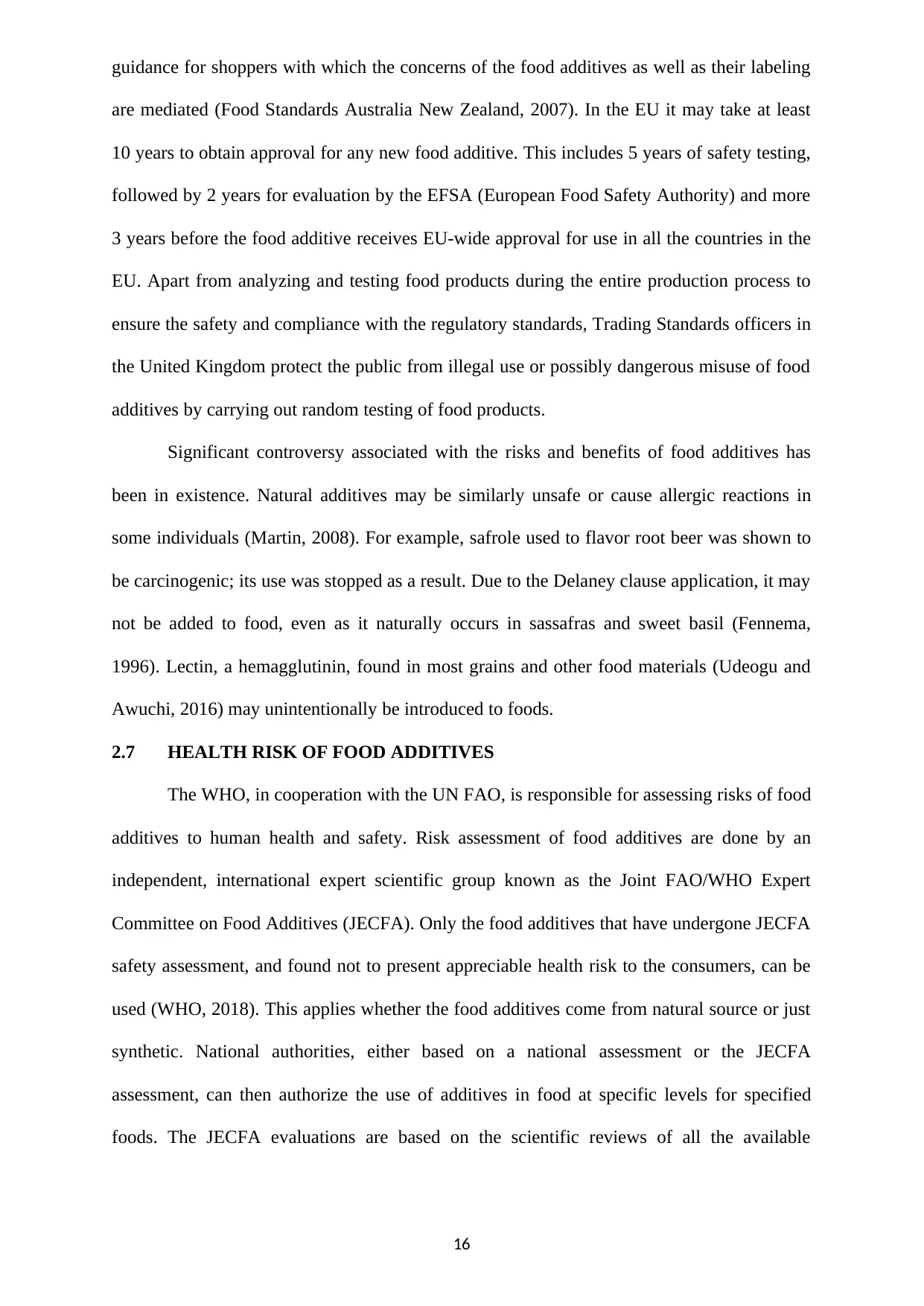
guidance for shoppers with which the concerns of the food additives as well as their labeling
are mediated (Food Standards Australia New Zealand, 2007). In the EU it may take at least
10 years to obtain approval for any new food additive. This includes 5 years of safety testing,
followed by 2 years for evaluation by the EFSA (European Food Safety Authority) and more
3 years before the food additive receives EU-wide approval for use in all the countries in the
EU. Apart from analyzing and testing food products during the entire production process to
ensure the safety and compliance with the regulatory standards, Trading Standards officers in
the United Kingdom protect the public from illegal use or possibly dangerous misuse of food
additives by carrying out random testing of food products.
Significant controversy associated with the risks and benefits of food additives has
been in existence. Natural additives may be similarly unsafe or cause allergic reactions in
some individuals (Martin, 2008). For example, safrole used to flavor root beer was shown to
be carcinogenic; its use was stopped as a result. Due to the Delaney clause application, it may
not be added to food, even as it naturally occurs in sassafras and sweet basil (Fennema,
1996). Lectin, a hemagglutinin, found in most grains and other food materials (Udeogu and
Awuchi, 2016) may unintentionally be introduced to foods.
2.7 HEALTH RISK OF FOOD ADDITIVES
The WHO, in cooperation with the UN FAO, is responsible for assessing risks of food
additives to human health and safety. Risk assessment of food additives are done by an
independent, international expert scientific group known as the Joint FAO/WHO Expert
Committee on Food Additives (JECFA). Only the food additives that have undergone JECFA
safety assessment, and found not to present appreciable health risk to the consumers, can be
used (WHO, 2018). This applies whether the food additives come from natural source or just
synthetic. National authorities, either based on a national assessment or the JECFA
assessment, can then authorize the use of additives in food at specific levels for specified
foods. The JECFA evaluations are based on the scientific reviews of all the available
16
are mediated (Food Standards Australia New Zealand, 2007). In the EU it may take at least
10 years to obtain approval for any new food additive. This includes 5 years of safety testing,
followed by 2 years for evaluation by the EFSA (European Food Safety Authority) and more
3 years before the food additive receives EU-wide approval for use in all the countries in the
EU. Apart from analyzing and testing food products during the entire production process to
ensure the safety and compliance with the regulatory standards, Trading Standards officers in
the United Kingdom protect the public from illegal use or possibly dangerous misuse of food
additives by carrying out random testing of food products.
Significant controversy associated with the risks and benefits of food additives has
been in existence. Natural additives may be similarly unsafe or cause allergic reactions in
some individuals (Martin, 2008). For example, safrole used to flavor root beer was shown to
be carcinogenic; its use was stopped as a result. Due to the Delaney clause application, it may
not be added to food, even as it naturally occurs in sassafras and sweet basil (Fennema,
1996). Lectin, a hemagglutinin, found in most grains and other food materials (Udeogu and
Awuchi, 2016) may unintentionally be introduced to foods.
2.7 HEALTH RISK OF FOOD ADDITIVES
The WHO, in cooperation with the UN FAO, is responsible for assessing risks of food
additives to human health and safety. Risk assessment of food additives are done by an
independent, international expert scientific group known as the Joint FAO/WHO Expert
Committee on Food Additives (JECFA). Only the food additives that have undergone JECFA
safety assessment, and found not to present appreciable health risk to the consumers, can be
used (WHO, 2018). This applies whether the food additives come from natural source or just
synthetic. National authorities, either based on a national assessment or the JECFA
assessment, can then authorize the use of additives in food at specific levels for specified
foods. The JECFA evaluations are based on the scientific reviews of all the available
16
Secure Best Marks with AI Grader
Need help grading? Try our AI Grader for instant feedback on your assignments.
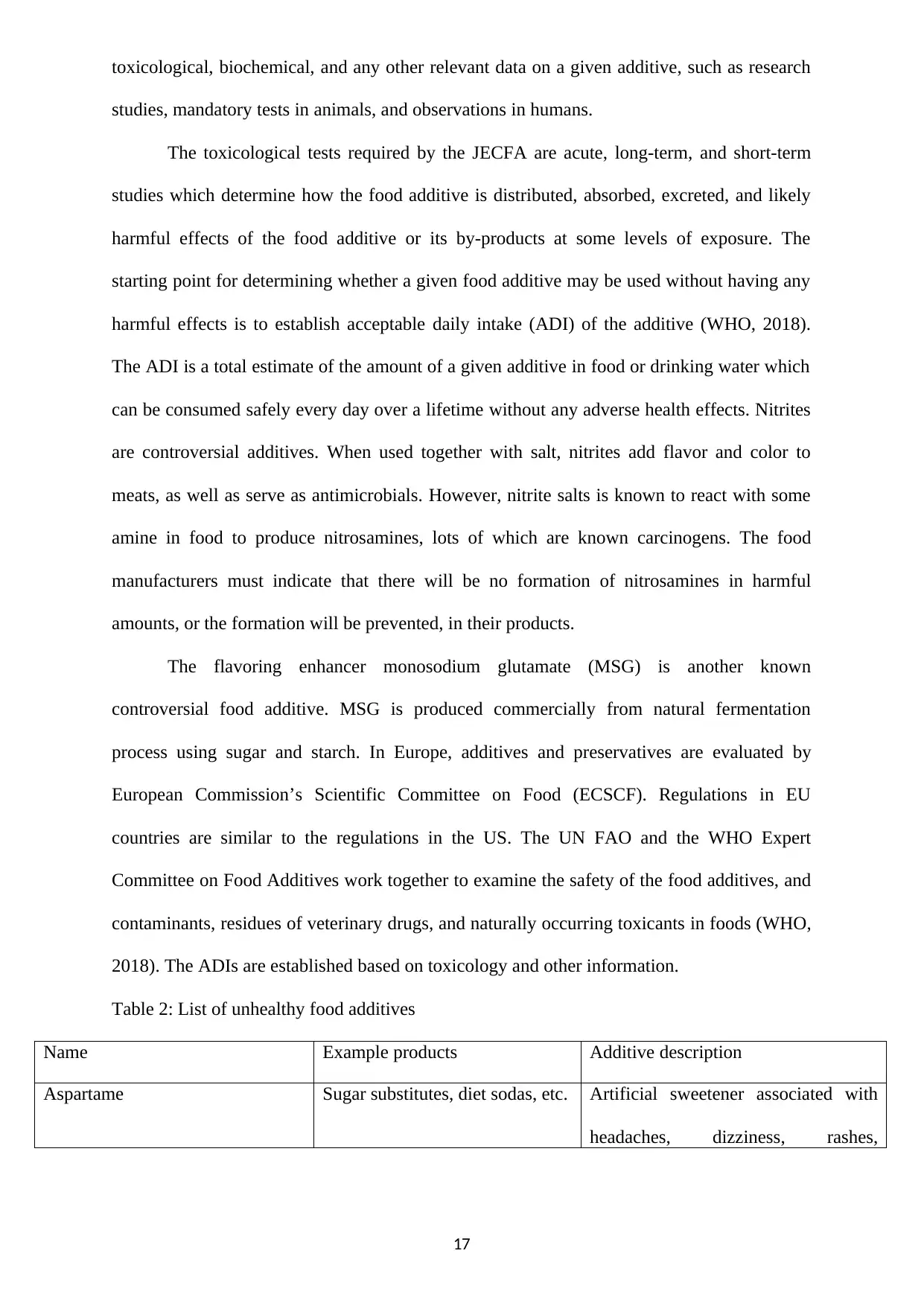
toxicological, biochemical, and any other relevant data on a given additive, such as research
studies, mandatory tests in animals, and observations in humans.
The toxicological tests required by the JECFA are acute, long-term, and short-term
studies which determine how the food additive is distributed, absorbed, excreted, and likely
harmful effects of the food additive or its by-products at some levels of exposure. The
starting point for determining whether a given food additive may be used without having any
harmful effects is to establish acceptable daily intake (ADI) of the additive (WHO, 2018).
The ADI is a total estimate of the amount of a given additive in food or drinking water which
can be consumed safely every day over a lifetime without any adverse health effects. Nitrites
are controversial additives. When used together with salt, nitrites add flavor and color to
meats, as well as serve as antimicrobials. However, nitrite salts is known to react with some
amine in food to produce nitrosamines, lots of which are known carcinogens. The food
manufacturers must indicate that there will be no formation of nitrosamines in harmful
amounts, or the formation will be prevented, in their products.
The flavoring enhancer monosodium glutamate (MSG) is another known
controversial food additive. MSG is produced commercially from natural fermentation
process using sugar and starch. In Europe, additives and preservatives are evaluated by
European Commission’s Scientific Committee on Food (ECSCF). Regulations in EU
countries are similar to the regulations in the US. The UN FAO and the WHO Expert
Committee on Food Additives work together to examine the safety of the food additives, and
contaminants, residues of veterinary drugs, and naturally occurring toxicants in foods (WHO,
2018). The ADIs are established based on toxicology and other information.
Table 2: List of unhealthy food additives
Name Example products Additive description
Aspartame Sugar substitutes, diet sodas, etc. Artificial sweetener associated with
headaches, dizziness, rashes,
17
studies, mandatory tests in animals, and observations in humans.
The toxicological tests required by the JECFA are acute, long-term, and short-term
studies which determine how the food additive is distributed, absorbed, excreted, and likely
harmful effects of the food additive or its by-products at some levels of exposure. The
starting point for determining whether a given food additive may be used without having any
harmful effects is to establish acceptable daily intake (ADI) of the additive (WHO, 2018).
The ADI is a total estimate of the amount of a given additive in food or drinking water which
can be consumed safely every day over a lifetime without any adverse health effects. Nitrites
are controversial additives. When used together with salt, nitrites add flavor and color to
meats, as well as serve as antimicrobials. However, nitrite salts is known to react with some
amine in food to produce nitrosamines, lots of which are known carcinogens. The food
manufacturers must indicate that there will be no formation of nitrosamines in harmful
amounts, or the formation will be prevented, in their products.
The flavoring enhancer monosodium glutamate (MSG) is another known
controversial food additive. MSG is produced commercially from natural fermentation
process using sugar and starch. In Europe, additives and preservatives are evaluated by
European Commission’s Scientific Committee on Food (ECSCF). Regulations in EU
countries are similar to the regulations in the US. The UN FAO and the WHO Expert
Committee on Food Additives work together to examine the safety of the food additives, and
contaminants, residues of veterinary drugs, and naturally occurring toxicants in foods (WHO,
2018). The ADIs are established based on toxicology and other information.
Table 2: List of unhealthy food additives
Name Example products Additive description
Aspartame Sugar substitutes, diet sodas, etc. Artificial sweetener associated with
headaches, dizziness, rashes,
17
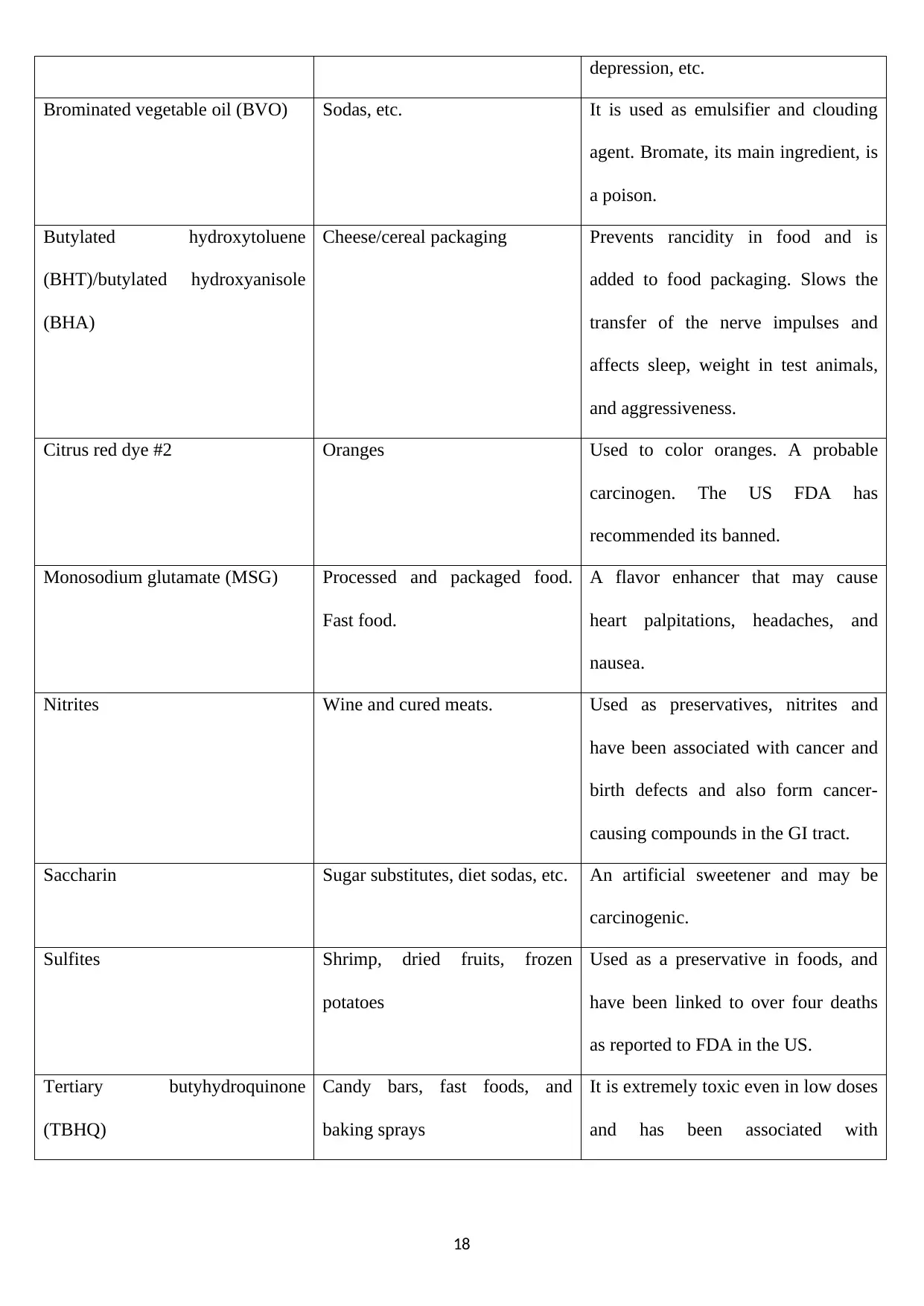
depression, etc.
Brominated vegetable oil (BVO) Sodas, etc. It is used as emulsifier and clouding
agent. Bromate, its main ingredient, is
a poison.
Butylated hydroxytoluene
(BHT)/butylated hydroxyanisole
(BHA)
Cheese/cereal packaging Prevents rancidity in food and is
added to food packaging. Slows the
transfer of the nerve impulses and
affects sleep, weight in test animals,
and aggressiveness.
Citrus red dye #2 Oranges Used to color oranges. A probable
carcinogen. The US FDA has
recommended its banned.
Monosodium glutamate (MSG) Processed and packaged food.
Fast food.
A flavor enhancer that may cause
heart palpitations, headaches, and
nausea.
Nitrites Wine and cured meats. Used as preservatives, nitrites and
have been associated with cancer and
birth defects and also form cancer-
causing compounds in the GI tract.
Saccharin Sugar substitutes, diet sodas, etc. An artificial sweetener and may be
carcinogenic.
Sulfites Shrimp, dried fruits, frozen
potatoes
Used as a preservative in foods, and
have been linked to over four deaths
as reported to FDA in the US.
Tertiary butyhydroquinone
(TBHQ)
Candy bars, fast foods, and
baking sprays
It is extremely toxic even in low doses
and has been associated with
18
Brominated vegetable oil (BVO) Sodas, etc. It is used as emulsifier and clouding
agent. Bromate, its main ingredient, is
a poison.
Butylated hydroxytoluene
(BHT)/butylated hydroxyanisole
(BHA)
Cheese/cereal packaging Prevents rancidity in food and is
added to food packaging. Slows the
transfer of the nerve impulses and
affects sleep, weight in test animals,
and aggressiveness.
Citrus red dye #2 Oranges Used to color oranges. A probable
carcinogen. The US FDA has
recommended its banned.
Monosodium glutamate (MSG) Processed and packaged food.
Fast food.
A flavor enhancer that may cause
heart palpitations, headaches, and
nausea.
Nitrites Wine and cured meats. Used as preservatives, nitrites and
have been associated with cancer and
birth defects and also form cancer-
causing compounds in the GI tract.
Saccharin Sugar substitutes, diet sodas, etc. An artificial sweetener and may be
carcinogenic.
Sulfites Shrimp, dried fruits, frozen
potatoes
Used as a preservative in foods, and
have been linked to over four deaths
as reported to FDA in the US.
Tertiary butyhydroquinone
(TBHQ)
Candy bars, fast foods, and
baking sprays
It is extremely toxic even in low doses
and has been associated with
18
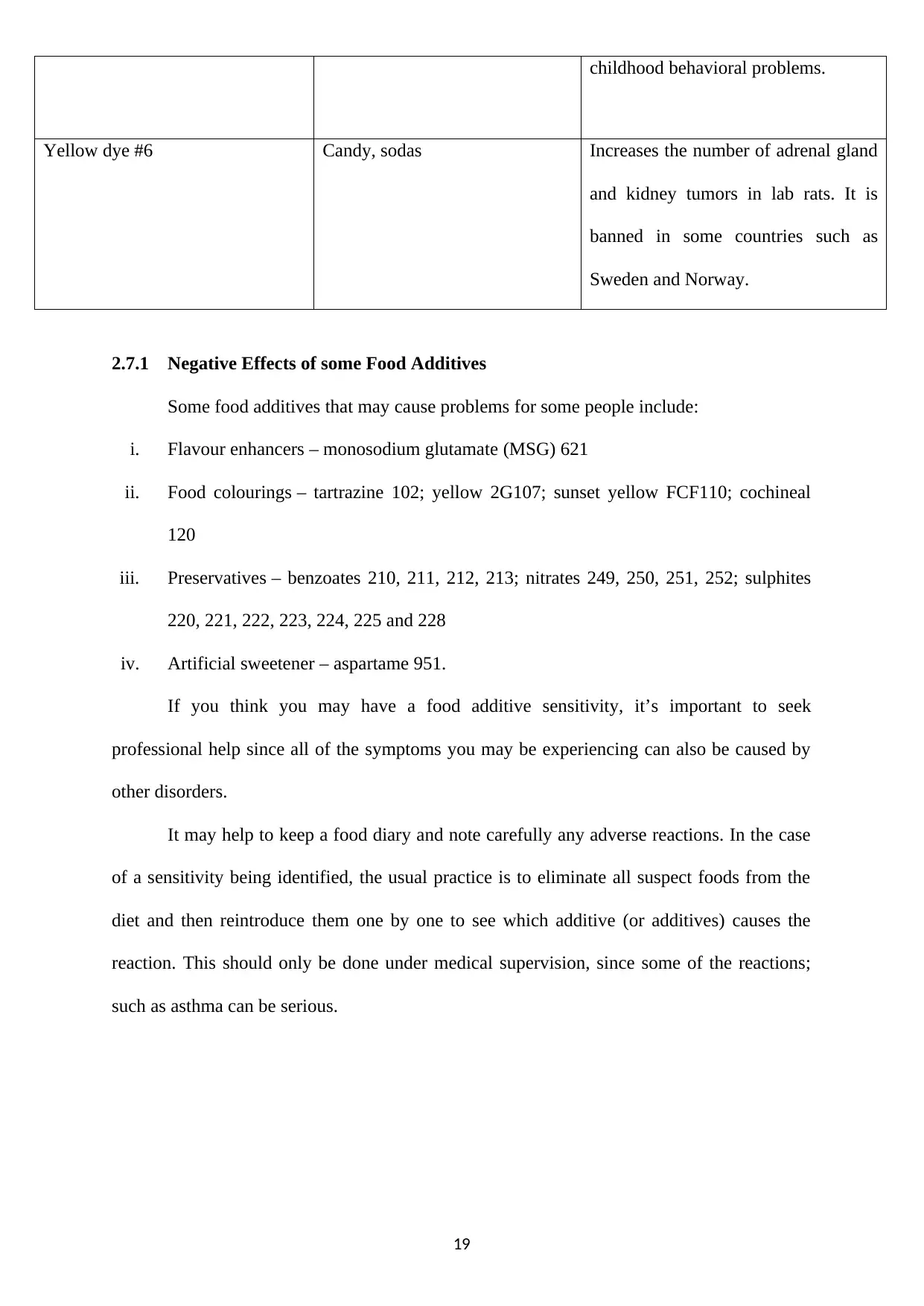
childhood behavioral problems.
Yellow dye #6 Candy, sodas Increases the number of adrenal gland
and kidney tumors in lab rats. It is
banned in some countries such as
Sweden and Norway.
2.7.1 Negative Effects of some Food Additives
Some food additives that may cause problems for some people include:
i. Flavour enhancers – monosodium glutamate (MSG) 621
ii. Food colourings – tartrazine 102; yellow 2G107; sunset yellow FCF110; cochineal
120
iii. Preservatives – benzoates 210, 211, 212, 213; nitrates 249, 250, 251, 252; sulphites
220, 221, 222, 223, 224, 225 and 228
iv. Artificial sweetener – aspartame 951.
If you think you may have a food additive sensitivity, it’s important to seek
professional help since all of the symptoms you may be experiencing can also be caused by
other disorders.
It may help to keep a food diary and note carefully any adverse reactions. In the case
of a sensitivity being identified, the usual practice is to eliminate all suspect foods from the
diet and then reintroduce them one by one to see which additive (or additives) causes the
reaction. This should only be done under medical supervision, since some of the reactions;
such as asthma can be serious.
19
Yellow dye #6 Candy, sodas Increases the number of adrenal gland
and kidney tumors in lab rats. It is
banned in some countries such as
Sweden and Norway.
2.7.1 Negative Effects of some Food Additives
Some food additives that may cause problems for some people include:
i. Flavour enhancers – monosodium glutamate (MSG) 621
ii. Food colourings – tartrazine 102; yellow 2G107; sunset yellow FCF110; cochineal
120
iii. Preservatives – benzoates 210, 211, 212, 213; nitrates 249, 250, 251, 252; sulphites
220, 221, 222, 223, 224, 225 and 228
iv. Artificial sweetener – aspartame 951.
If you think you may have a food additive sensitivity, it’s important to seek
professional help since all of the symptoms you may be experiencing can also be caused by
other disorders.
It may help to keep a food diary and note carefully any adverse reactions. In the case
of a sensitivity being identified, the usual practice is to eliminate all suspect foods from the
diet and then reintroduce them one by one to see which additive (or additives) causes the
reaction. This should only be done under medical supervision, since some of the reactions;
such as asthma can be serious.
19
Paraphrase This Document
Need a fresh take? Get an instant paraphrase of this document with our AI Paraphraser
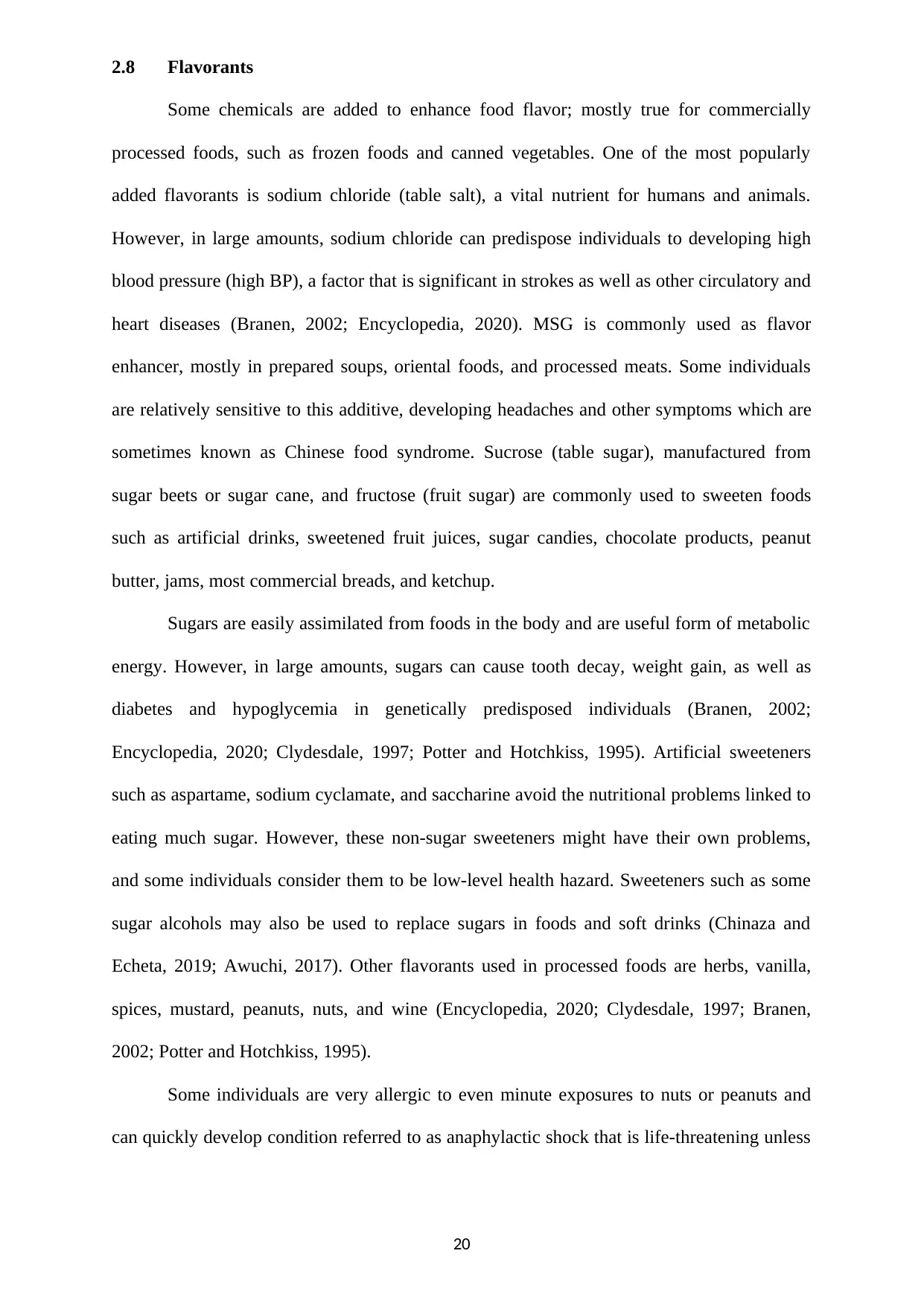
2.8 Flavorants
Some chemicals are added to enhance food flavor; mostly true for commercially
processed foods, such as frozen foods and canned vegetables. One of the most popularly
added flavorants is sodium chloride (table salt), a vital nutrient for humans and animals.
However, in large amounts, sodium chloride can predispose individuals to developing high
blood pressure (high BP), a factor that is significant in strokes as well as other circulatory and
heart diseases (Branen, 2002; Encyclopedia, 2020). MSG is commonly used as flavor
enhancer, mostly in prepared soups, oriental foods, and processed meats. Some individuals
are relatively sensitive to this additive, developing headaches and other symptoms which are
sometimes known as Chinese food syndrome. Sucrose (table sugar), manufactured from
sugar beets or sugar cane, and fructose (fruit sugar) are commonly used to sweeten foods
such as artificial drinks, sweetened fruit juices, sugar candies, chocolate products, peanut
butter, jams, most commercial breads, and ketchup.
Sugars are easily assimilated from foods in the body and are useful form of metabolic
energy. However, in large amounts, sugars can cause tooth decay, weight gain, as well as
diabetes and hypoglycemia in genetically predisposed individuals (Branen, 2002;
Encyclopedia, 2020; Clydesdale, 1997; Potter and Hotchkiss, 1995). Artificial sweeteners
such as aspartame, sodium cyclamate, and saccharine avoid the nutritional problems linked to
eating much sugar. However, these non-sugar sweeteners might have their own problems,
and some individuals consider them to be low-level health hazard. Sweeteners such as some
sugar alcohols may also be used to replace sugars in foods and soft drinks (Chinaza and
Echeta, 2019; Awuchi, 2017). Other flavorants used in processed foods are herbs, vanilla,
spices, mustard, peanuts, nuts, and wine (Encyclopedia, 2020; Clydesdale, 1997; Branen,
2002; Potter and Hotchkiss, 1995).
Some individuals are very allergic to even minute exposures to nuts or peanuts and
can quickly develop condition referred to as anaphylactic shock that is life-threatening unless
20
Some chemicals are added to enhance food flavor; mostly true for commercially
processed foods, such as frozen foods and canned vegetables. One of the most popularly
added flavorants is sodium chloride (table salt), a vital nutrient for humans and animals.
However, in large amounts, sodium chloride can predispose individuals to developing high
blood pressure (high BP), a factor that is significant in strokes as well as other circulatory and
heart diseases (Branen, 2002; Encyclopedia, 2020). MSG is commonly used as flavor
enhancer, mostly in prepared soups, oriental foods, and processed meats. Some individuals
are relatively sensitive to this additive, developing headaches and other symptoms which are
sometimes known as Chinese food syndrome. Sucrose (table sugar), manufactured from
sugar beets or sugar cane, and fructose (fruit sugar) are commonly used to sweeten foods
such as artificial drinks, sweetened fruit juices, sugar candies, chocolate products, peanut
butter, jams, most commercial breads, and ketchup.
Sugars are easily assimilated from foods in the body and are useful form of metabolic
energy. However, in large amounts, sugars can cause tooth decay, weight gain, as well as
diabetes and hypoglycemia in genetically predisposed individuals (Branen, 2002;
Encyclopedia, 2020; Clydesdale, 1997; Potter and Hotchkiss, 1995). Artificial sweeteners
such as aspartame, sodium cyclamate, and saccharine avoid the nutritional problems linked to
eating much sugar. However, these non-sugar sweeteners might have their own problems,
and some individuals consider them to be low-level health hazard. Sweeteners such as some
sugar alcohols may also be used to replace sugars in foods and soft drinks (Chinaza and
Echeta, 2019; Awuchi, 2017). Other flavorants used in processed foods are herbs, vanilla,
spices, mustard, peanuts, nuts, and wine (Encyclopedia, 2020; Clydesdale, 1997; Branen,
2002; Potter and Hotchkiss, 1995).
Some individuals are very allergic to even minute exposures to nuts or peanuts and
can quickly develop condition referred to as anaphylactic shock that is life-threatening unless
20

rapidly treated with medication. Many flavorants are natural. However, synthetic flavorants
are increasingly being discovered and used in home and food industries; vanilla was extracted
only from particular species of tropical orchid, which made it rather expensive flavorant.
Currently, a synthetic vanilla flavorant can be manufactured from wood-pulp lignins, making
the pleasant flavor more readily available and less expensive than it was.
21
are increasingly being discovered and used in home and food industries; vanilla was extracted
only from particular species of tropical orchid, which made it rather expensive flavorant.
Currently, a synthetic vanilla flavorant can be manufactured from wood-pulp lignins, making
the pleasant flavor more readily available and less expensive than it was.
21
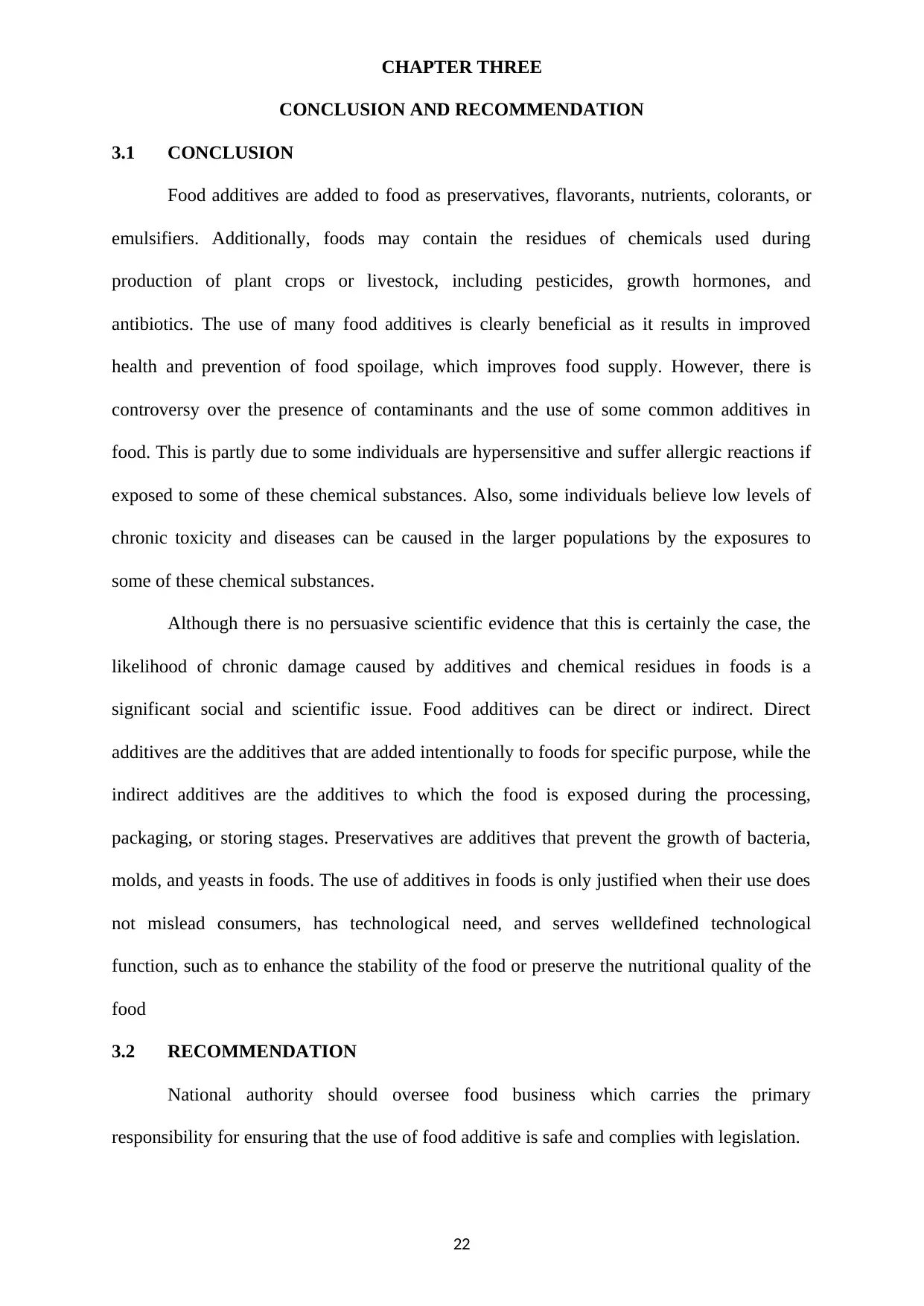
CHAPTER THREE
CONCLUSION AND RECOMMENDATION
3.1 CONCLUSION
Food additives are added to food as preservatives, flavorants, nutrients, colorants, or
emulsifiers. Additionally, foods may contain the residues of chemicals used during
production of plant crops or livestock, including pesticides, growth hormones, and
antibiotics. The use of many food additives is clearly beneficial as it results in improved
health and prevention of food spoilage, which improves food supply. However, there is
controversy over the presence of contaminants and the use of some common additives in
food. This is partly due to some individuals are hypersensitive and suffer allergic reactions if
exposed to some of these chemical substances. Also, some individuals believe low levels of
chronic toxicity and diseases can be caused in the larger populations by the exposures to
some of these chemical substances.
Although there is no persuasive scientific evidence that this is certainly the case, the
likelihood of chronic damage caused by additives and chemical residues in foods is a
significant social and scientific issue. Food additives can be direct or indirect. Direct
additives are the additives that are added intentionally to foods for specific purpose, while the
indirect additives are the additives to which the food is exposed during the processing,
packaging, or storing stages. Preservatives are additives that prevent the growth of bacteria,
molds, and yeasts in foods. The use of additives in foods is only justified when their use does
not mislead consumers, has technological need, and serves welldefined technological
function, such as to enhance the stability of the food or preserve the nutritional quality of the
food
3.2 RECOMMENDATION
National authority should oversee food business which carries the primary
responsibility for ensuring that the use of food additive is safe and complies with legislation.
22
CONCLUSION AND RECOMMENDATION
3.1 CONCLUSION
Food additives are added to food as preservatives, flavorants, nutrients, colorants, or
emulsifiers. Additionally, foods may contain the residues of chemicals used during
production of plant crops or livestock, including pesticides, growth hormones, and
antibiotics. The use of many food additives is clearly beneficial as it results in improved
health and prevention of food spoilage, which improves food supply. However, there is
controversy over the presence of contaminants and the use of some common additives in
food. This is partly due to some individuals are hypersensitive and suffer allergic reactions if
exposed to some of these chemical substances. Also, some individuals believe low levels of
chronic toxicity and diseases can be caused in the larger populations by the exposures to
some of these chemical substances.
Although there is no persuasive scientific evidence that this is certainly the case, the
likelihood of chronic damage caused by additives and chemical residues in foods is a
significant social and scientific issue. Food additives can be direct or indirect. Direct
additives are the additives that are added intentionally to foods for specific purpose, while the
indirect additives are the additives to which the food is exposed during the processing,
packaging, or storing stages. Preservatives are additives that prevent the growth of bacteria,
molds, and yeasts in foods. The use of additives in foods is only justified when their use does
not mislead consumers, has technological need, and serves welldefined technological
function, such as to enhance the stability of the food or preserve the nutritional quality of the
food
3.2 RECOMMENDATION
National authority should oversee food business which carries the primary
responsibility for ensuring that the use of food additive is safe and complies with legislation.
22
Secure Best Marks with AI Grader
Need help grading? Try our AI Grader for instant feedback on your assignments.
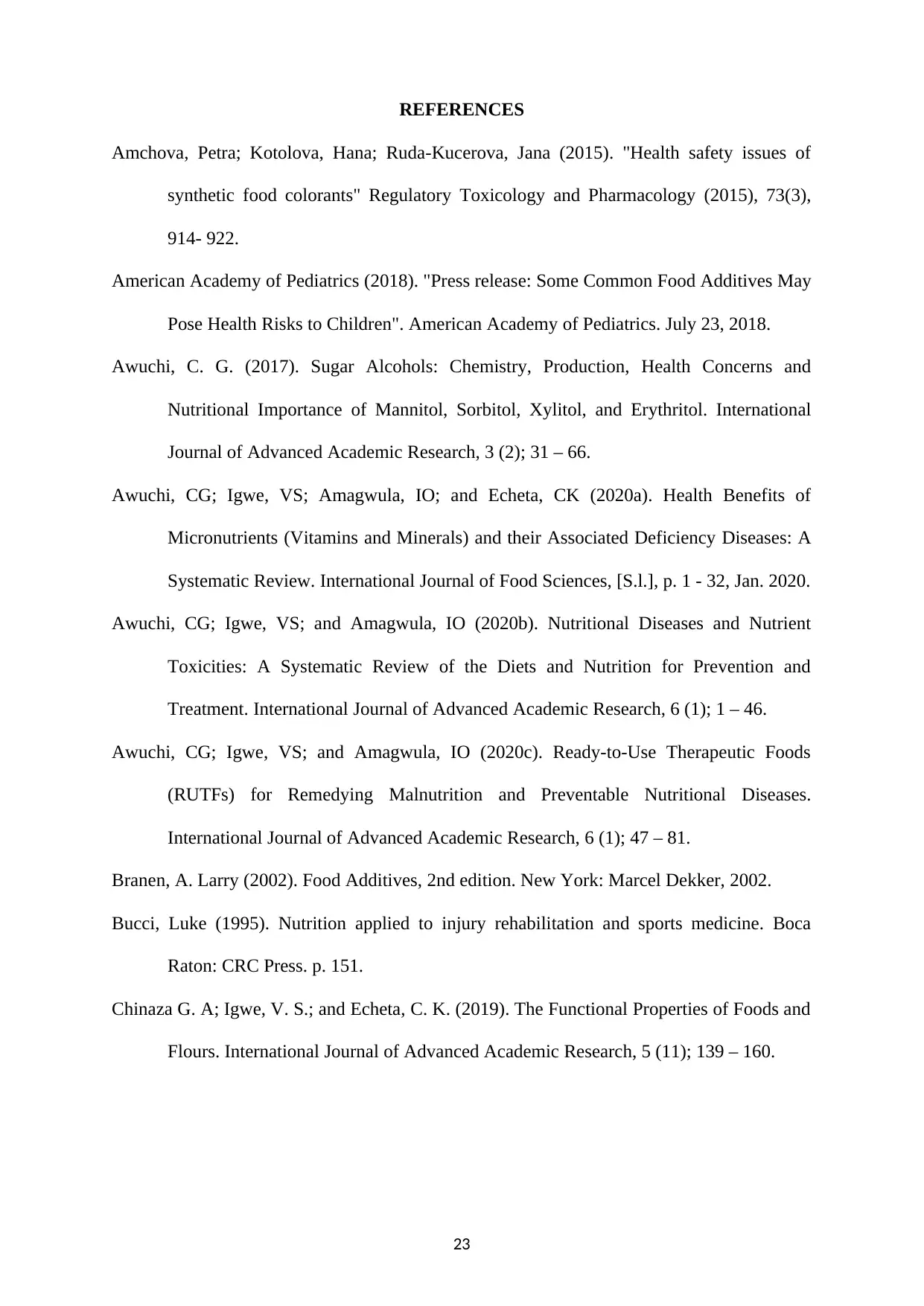
REFERENCES
Amchova, Petra; Kotolova, Hana; Ruda-Kucerova, Jana (2015). "Health safety issues of
synthetic food colorants" Regulatory Toxicology and Pharmacology (2015), 73(3),
914- 922.
American Academy of Pediatrics (2018). "Press release: Some Common Food Additives May
Pose Health Risks to Children". American Academy of Pediatrics. July 23, 2018.
Awuchi, C. G. (2017). Sugar Alcohols: Chemistry, Production, Health Concerns and
Nutritional Importance of Mannitol, Sorbitol, Xylitol, and Erythritol. International
Journal of Advanced Academic Research, 3 (2); 31 – 66.
Awuchi, CG; Igwe, VS; Amagwula, IO; and Echeta, CK (2020a). Health Benefits of
Micronutrients (Vitamins and Minerals) and their Associated Deficiency Diseases: A
Systematic Review. International Journal of Food Sciences, [S.l.], p. 1 - 32, Jan. 2020.
Awuchi, CG; Igwe, VS; and Amagwula, IO (2020b). Nutritional Diseases and Nutrient
Toxicities: A Systematic Review of the Diets and Nutrition for Prevention and
Treatment. International Journal of Advanced Academic Research, 6 (1); 1 – 46.
Awuchi, CG; Igwe, VS; and Amagwula, IO (2020c). Ready-to-Use Therapeutic Foods
(RUTFs) for Remedying Malnutrition and Preventable Nutritional Diseases.
International Journal of Advanced Academic Research, 6 (1); 47 – 81.
Branen, A. Larry (2002). Food Additives, 2nd edition. New York: Marcel Dekker, 2002.
Bucci, Luke (1995). Nutrition applied to injury rehabilitation and sports medicine. Boca
Raton: CRC Press. p. 151.
Chinaza G. A; Igwe, V. S.; and Echeta, C. K. (2019). The Functional Properties of Foods and
Flours. International Journal of Advanced Academic Research, 5 (11); 139 – 160.
23
Amchova, Petra; Kotolova, Hana; Ruda-Kucerova, Jana (2015). "Health safety issues of
synthetic food colorants" Regulatory Toxicology and Pharmacology (2015), 73(3),
914- 922.
American Academy of Pediatrics (2018). "Press release: Some Common Food Additives May
Pose Health Risks to Children". American Academy of Pediatrics. July 23, 2018.
Awuchi, C. G. (2017). Sugar Alcohols: Chemistry, Production, Health Concerns and
Nutritional Importance of Mannitol, Sorbitol, Xylitol, and Erythritol. International
Journal of Advanced Academic Research, 3 (2); 31 – 66.
Awuchi, CG; Igwe, VS; Amagwula, IO; and Echeta, CK (2020a). Health Benefits of
Micronutrients (Vitamins and Minerals) and their Associated Deficiency Diseases: A
Systematic Review. International Journal of Food Sciences, [S.l.], p. 1 - 32, Jan. 2020.
Awuchi, CG; Igwe, VS; and Amagwula, IO (2020b). Nutritional Diseases and Nutrient
Toxicities: A Systematic Review of the Diets and Nutrition for Prevention and
Treatment. International Journal of Advanced Academic Research, 6 (1); 1 – 46.
Awuchi, CG; Igwe, VS; and Amagwula, IO (2020c). Ready-to-Use Therapeutic Foods
(RUTFs) for Remedying Malnutrition and Preventable Nutritional Diseases.
International Journal of Advanced Academic Research, 6 (1); 47 – 81.
Branen, A. Larry (2002). Food Additives, 2nd edition. New York: Marcel Dekker, 2002.
Bucci, Luke (1995). Nutrition applied to injury rehabilitation and sports medicine. Boca
Raton: CRC Press. p. 151.
Chinaza G. A; Igwe, V. S.; and Echeta, C. K. (2019). The Functional Properties of Foods and
Flours. International Journal of Advanced Academic Research, 5 (11); 139 – 160.
23
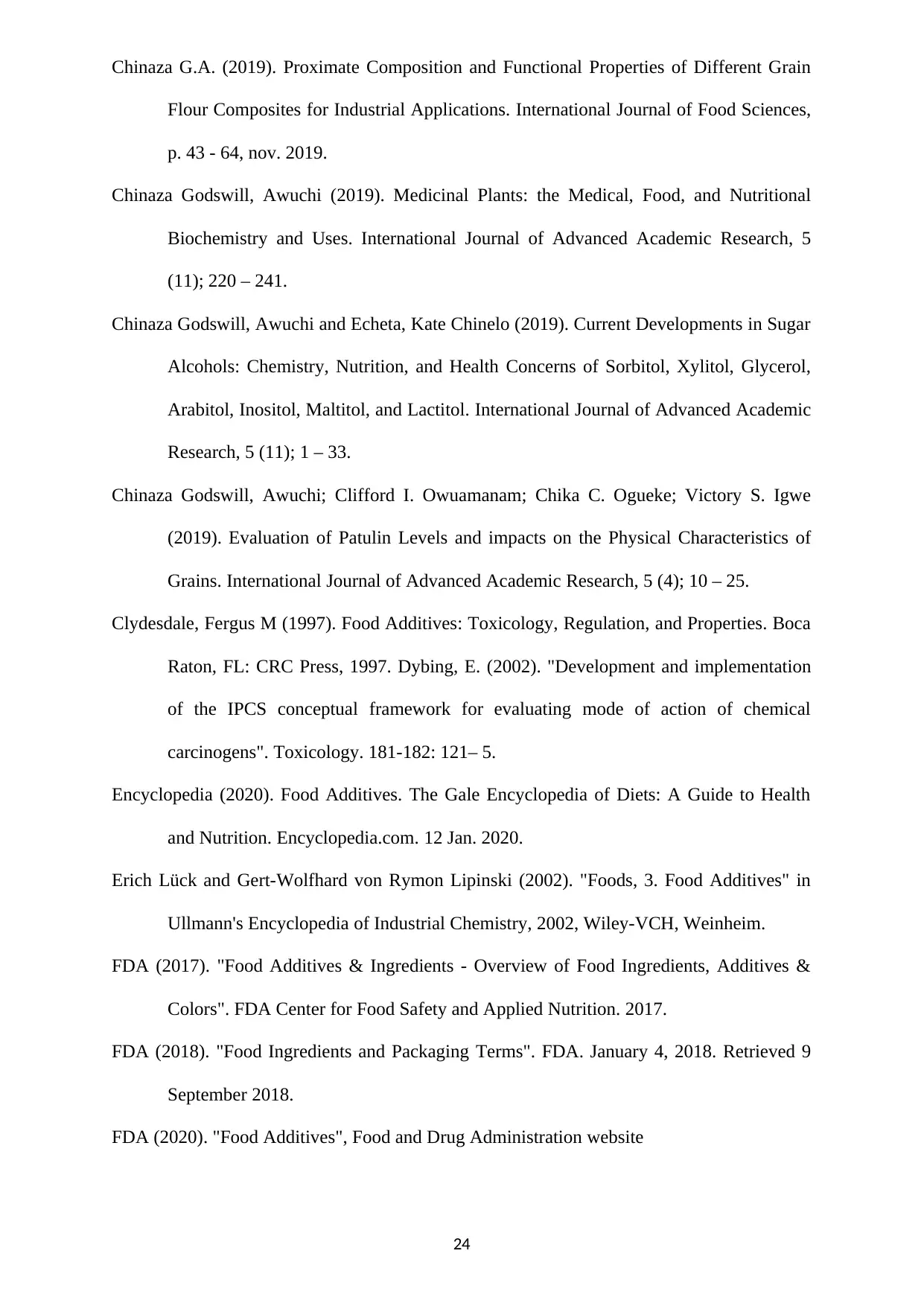
Chinaza G.A. (2019). Proximate Composition and Functional Properties of Different Grain
Flour Composites for Industrial Applications. International Journal of Food Sciences,
p. 43 - 64, nov. 2019.
Chinaza Godswill, Awuchi (2019). Medicinal Plants: the Medical, Food, and Nutritional
Biochemistry and Uses. International Journal of Advanced Academic Research, 5
(11); 220 – 241.
Chinaza Godswill, Awuchi and Echeta, Kate Chinelo (2019). Current Developments in Sugar
Alcohols: Chemistry, Nutrition, and Health Concerns of Sorbitol, Xylitol, Glycerol,
Arabitol, Inositol, Maltitol, and Lactitol. International Journal of Advanced Academic
Research, 5 (11); 1 – 33.
Chinaza Godswill, Awuchi; Clifford I. Owuamanam; Chika C. Ogueke; Victory S. Igwe
(2019). Evaluation of Patulin Levels and impacts on the Physical Characteristics of
Grains. International Journal of Advanced Academic Research, 5 (4); 10 – 25.
Clydesdale, Fergus M (1997). Food Additives: Toxicology, Regulation, and Properties. Boca
Raton, FL: CRC Press, 1997. Dybing, E. (2002). "Development and implementation
of the IPCS conceptual framework for evaluating mode of action of chemical
carcinogens". Toxicology. 181-182: 121– 5.
Encyclopedia (2020). Food Additives. The Gale Encyclopedia of Diets: A Guide to Health
and Nutrition. Encyclopedia.com. 12 Jan. 2020.
Erich Lück and Gert-Wolfhard von Rymon Lipinski (2002). "Foods, 3. Food Additives" in
Ullmann's Encyclopedia of Industrial Chemistry, 2002, Wiley-VCH, Weinheim.
FDA (2017). "Food Additives & Ingredients - Overview of Food Ingredients, Additives &
Colors". FDA Center for Food Safety and Applied Nutrition. 2017.
FDA (2018). "Food Ingredients and Packaging Terms". FDA. January 4, 2018. Retrieved 9
September 2018.
FDA (2020). "Food Additives", Food and Drug Administration website
24
Flour Composites for Industrial Applications. International Journal of Food Sciences,
p. 43 - 64, nov. 2019.
Chinaza Godswill, Awuchi (2019). Medicinal Plants: the Medical, Food, and Nutritional
Biochemistry and Uses. International Journal of Advanced Academic Research, 5
(11); 220 – 241.
Chinaza Godswill, Awuchi and Echeta, Kate Chinelo (2019). Current Developments in Sugar
Alcohols: Chemistry, Nutrition, and Health Concerns of Sorbitol, Xylitol, Glycerol,
Arabitol, Inositol, Maltitol, and Lactitol. International Journal of Advanced Academic
Research, 5 (11); 1 – 33.
Chinaza Godswill, Awuchi; Clifford I. Owuamanam; Chika C. Ogueke; Victory S. Igwe
(2019). Evaluation of Patulin Levels and impacts on the Physical Characteristics of
Grains. International Journal of Advanced Academic Research, 5 (4); 10 – 25.
Clydesdale, Fergus M (1997). Food Additives: Toxicology, Regulation, and Properties. Boca
Raton, FL: CRC Press, 1997. Dybing, E. (2002). "Development and implementation
of the IPCS conceptual framework for evaluating mode of action of chemical
carcinogens". Toxicology. 181-182: 121– 5.
Encyclopedia (2020). Food Additives. The Gale Encyclopedia of Diets: A Guide to Health
and Nutrition. Encyclopedia.com. 12 Jan. 2020.
Erich Lück and Gert-Wolfhard von Rymon Lipinski (2002). "Foods, 3. Food Additives" in
Ullmann's Encyclopedia of Industrial Chemistry, 2002, Wiley-VCH, Weinheim.
FDA (2017). "Food Additives & Ingredients - Overview of Food Ingredients, Additives &
Colors". FDA Center for Food Safety and Applied Nutrition. 2017.
FDA (2018). "Food Ingredients and Packaging Terms". FDA. January 4, 2018. Retrieved 9
September 2018.
FDA (2020). "Food Additives", Food and Drug Administration website
24
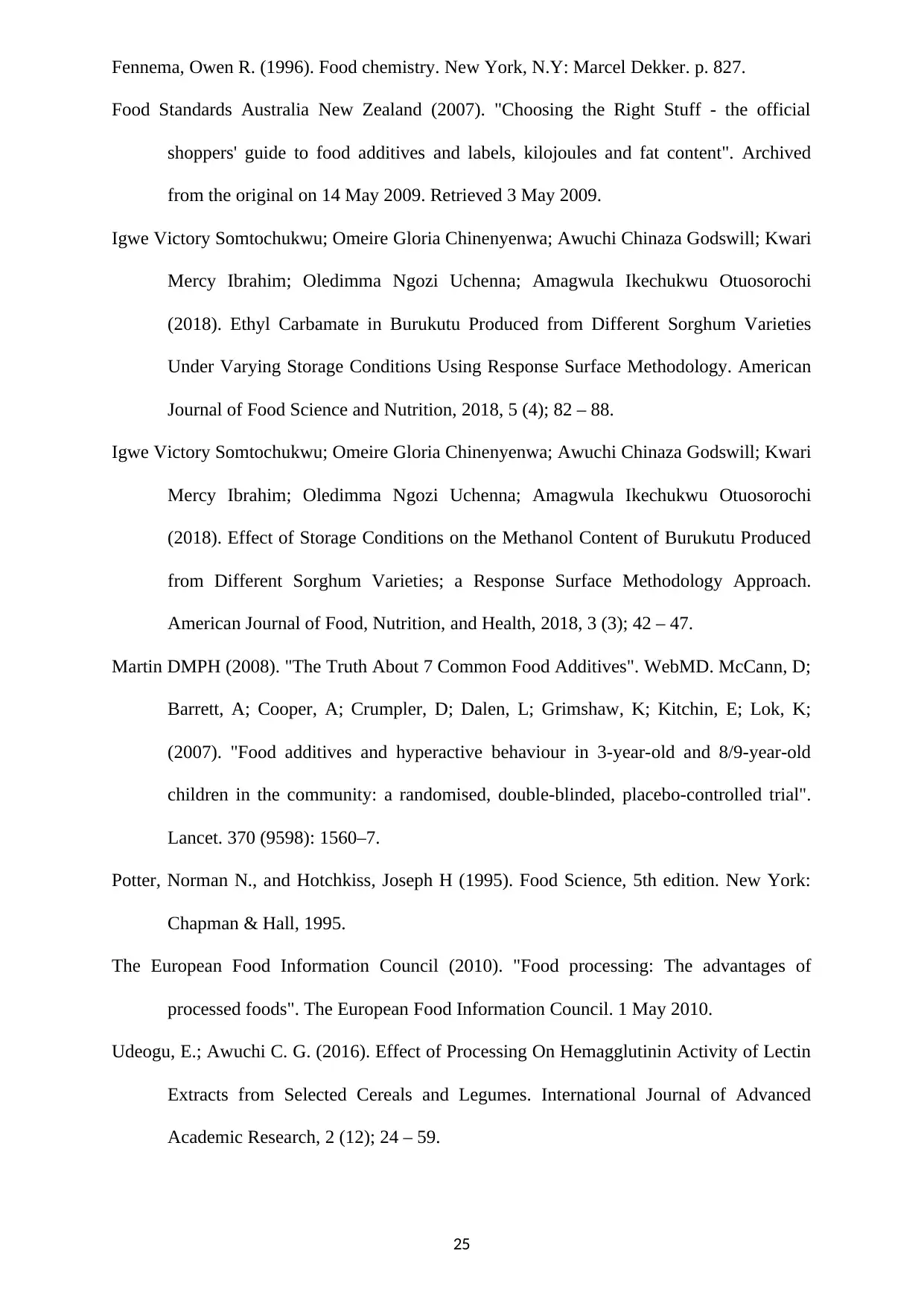
Fennema, Owen R. (1996). Food chemistry. New York, N.Y: Marcel Dekker. p. 827.
Food Standards Australia New Zealand (2007). "Choosing the Right Stuff - the official
shoppers' guide to food additives and labels, kilojoules and fat content". Archived
from the original on 14 May 2009. Retrieved 3 May 2009.
Igwe Victory Somtochukwu; Omeire Gloria Chinenyenwa; Awuchi Chinaza Godswill; Kwari
Mercy Ibrahim; Oledimma Ngozi Uchenna; Amagwula Ikechukwu Otuosorochi
(2018). Ethyl Carbamate in Burukutu Produced from Different Sorghum Varieties
Under Varying Storage Conditions Using Response Surface Methodology. American
Journal of Food Science and Nutrition, 2018, 5 (4); 82 – 88.
Igwe Victory Somtochukwu; Omeire Gloria Chinenyenwa; Awuchi Chinaza Godswill; Kwari
Mercy Ibrahim; Oledimma Ngozi Uchenna; Amagwula Ikechukwu Otuosorochi
(2018). Effect of Storage Conditions on the Methanol Content of Burukutu Produced
from Different Sorghum Varieties; a Response Surface Methodology Approach.
American Journal of Food, Nutrition, and Health, 2018, 3 (3); 42 – 47.
Martin DMPH (2008). "The Truth About 7 Common Food Additives". WebMD. McCann, D;
Barrett, A; Cooper, A; Crumpler, D; Dalen, L; Grimshaw, K; Kitchin, E; Lok, K;
(2007). "Food additives and hyperactive behaviour in 3-year-old and 8/9-year-old
children in the community: a randomised, double-blinded, placebo-controlled trial".
Lancet. 370 (9598): 1560–7.
Potter, Norman N., and Hotchkiss, Joseph H (1995). Food Science, 5th edition. New York:
Chapman & Hall, 1995.
The European Food Information Council (2010). "Food processing: The advantages of
processed foods". The European Food Information Council. 1 May 2010.
Udeogu, E.; Awuchi C. G. (2016). Effect of Processing On Hemagglutinin Activity of Lectin
Extracts from Selected Cereals and Legumes. International Journal of Advanced
Academic Research, 2 (12); 24 – 59.
25
Food Standards Australia New Zealand (2007). "Choosing the Right Stuff - the official
shoppers' guide to food additives and labels, kilojoules and fat content". Archived
from the original on 14 May 2009. Retrieved 3 May 2009.
Igwe Victory Somtochukwu; Omeire Gloria Chinenyenwa; Awuchi Chinaza Godswill; Kwari
Mercy Ibrahim; Oledimma Ngozi Uchenna; Amagwula Ikechukwu Otuosorochi
(2018). Ethyl Carbamate in Burukutu Produced from Different Sorghum Varieties
Under Varying Storage Conditions Using Response Surface Methodology. American
Journal of Food Science and Nutrition, 2018, 5 (4); 82 – 88.
Igwe Victory Somtochukwu; Omeire Gloria Chinenyenwa; Awuchi Chinaza Godswill; Kwari
Mercy Ibrahim; Oledimma Ngozi Uchenna; Amagwula Ikechukwu Otuosorochi
(2018). Effect of Storage Conditions on the Methanol Content of Burukutu Produced
from Different Sorghum Varieties; a Response Surface Methodology Approach.
American Journal of Food, Nutrition, and Health, 2018, 3 (3); 42 – 47.
Martin DMPH (2008). "The Truth About 7 Common Food Additives". WebMD. McCann, D;
Barrett, A; Cooper, A; Crumpler, D; Dalen, L; Grimshaw, K; Kitchin, E; Lok, K;
(2007). "Food additives and hyperactive behaviour in 3-year-old and 8/9-year-old
children in the community: a randomised, double-blinded, placebo-controlled trial".
Lancet. 370 (9598): 1560–7.
Potter, Norman N., and Hotchkiss, Joseph H (1995). Food Science, 5th edition. New York:
Chapman & Hall, 1995.
The European Food Information Council (2010). "Food processing: The advantages of
processed foods". The European Food Information Council. 1 May 2010.
Udeogu, E.; Awuchi C. G. (2016). Effect of Processing On Hemagglutinin Activity of Lectin
Extracts from Selected Cereals and Legumes. International Journal of Advanced
Academic Research, 2 (12); 24 – 59.
25
Paraphrase This Document
Need a fresh take? Get an instant paraphrase of this document with our AI Paraphraser
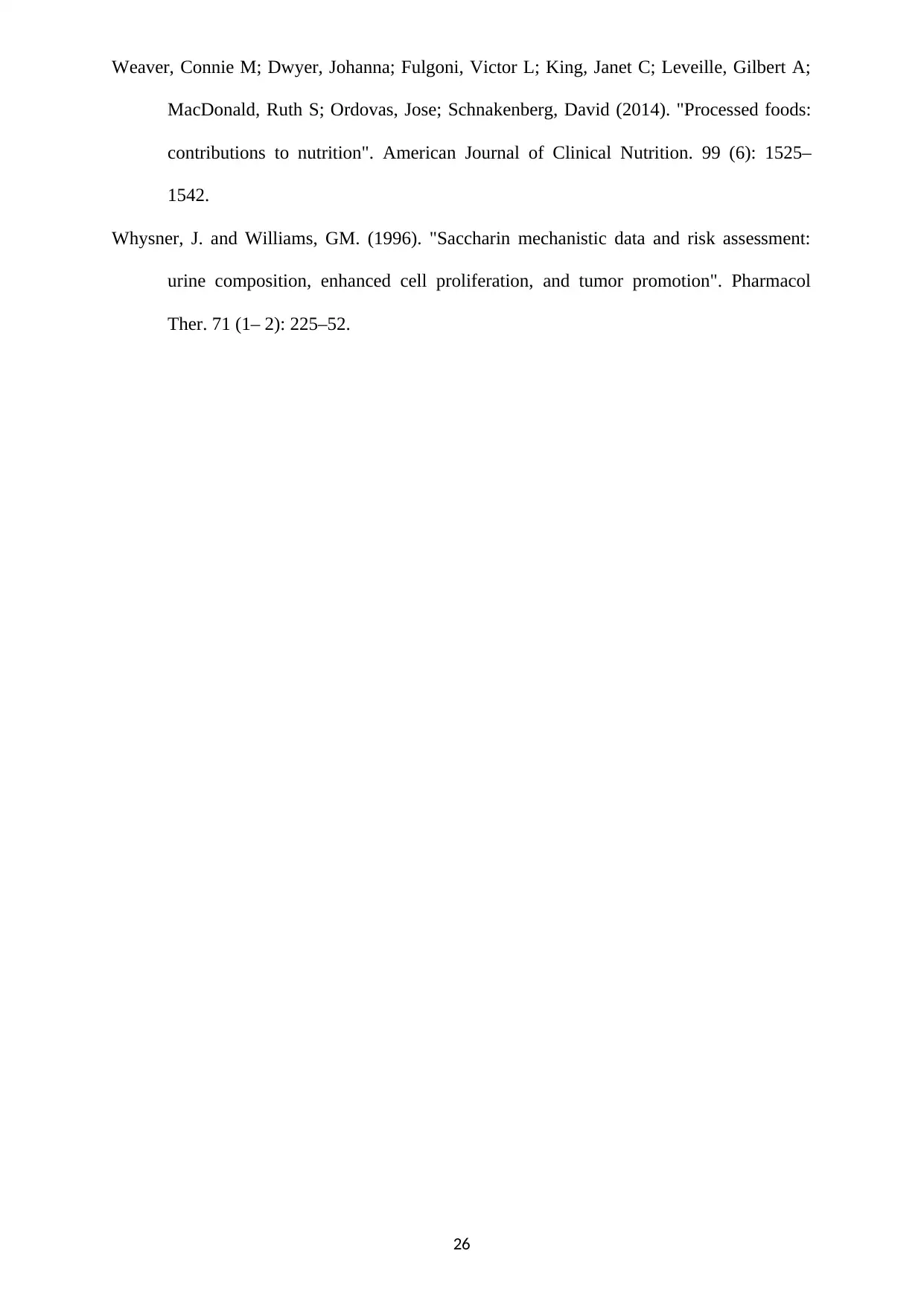
Weaver, Connie M; Dwyer, Johanna; Fulgoni, Victor L; King, Janet C; Leveille, Gilbert A;
MacDonald, Ruth S; Ordovas, Jose; Schnakenberg, David (2014). "Processed foods:
contributions to nutrition". American Journal of Clinical Nutrition. 99 (6): 1525–
1542.
Whysner, J. and Williams, GM. (1996). "Saccharin mechanistic data and risk assessment:
urine composition, enhanced cell proliferation, and tumor promotion". Pharmacol
Ther. 71 (1– 2): 225–52.
26
MacDonald, Ruth S; Ordovas, Jose; Schnakenberg, David (2014). "Processed foods:
contributions to nutrition". American Journal of Clinical Nutrition. 99 (6): 1525–
1542.
Whysner, J. and Williams, GM. (1996). "Saccharin mechanistic data and risk assessment:
urine composition, enhanced cell proliferation, and tumor promotion". Pharmacol
Ther. 71 (1– 2): 225–52.
26
1 out of 26
Your All-in-One AI-Powered Toolkit for Academic Success.
+13062052269
info@desklib.com
Available 24*7 on WhatsApp / Email
![[object Object]](/_next/static/media/star-bottom.7253800d.svg)
Unlock your academic potential
© 2024 | Zucol Services PVT LTD | All rights reserved.